Sri Lanka, known as the Pearl of the Orient, is 270-mile by 140-mile island that sits of the tip of India. Despite only being slightly larger than West Virginia, it’s one of the most diverse and unique travel destinations in the world. Tropical waters wash onto sandy beaches around more than a thousand miles of coastline. Over three thousand years of history and culture fill the temples and museums waiting to be discovered. The diverse landscape from mountain highlands to tropical savanna gives Sri Lanka the highest biodiversity in Asia. Sri Lanka fuels the spirit of adventure for all who visit.
Sri Lanka suffered through a devastating 26-year civil war that ended in 2009. Now that peace has returned, the country is turning to tourism for prosperity. Intrepid travelers can find amazing adventures at bargain prices if they know where to look. What’s more, the money you spend in Sri Lanka will help restore and rebuild this beautiful country. We took the top destinations from twenty-four travel writer’s personal trips to Sri Lanka to form this guide. From the beaches to the mountains and culture to critters, let us guide you through this world-class destination.
Sri Lanka Quick Hitters
- Currency: Sri Lankan Rupee (LKR)
- Visa: Almost every visitor will need a visa. Apply online for an ETA Travel Visa before you go. Make sure you print your visa too. We didn’t have trouble with a digital copy, but we know travelers who have.
- Language: 70% of the population speaks Sinhala. About 30% of the people, primarily in the Northern and Eastern districts speak Tamil. Most people also speak conversational English, especially in tourist areas, so you should not have difficulty getting around.
- Safety: The US State Department recommends visitors exercise normal precautions when traveling to Sri Lanka. This recommendation is their lowest risk level assigned to any country and lower than many destinations in Europe.
- Health Concerns: The Center for Disease Control recommends travelers have current routine vaccinations and most travelers should get Hepatitis A and Typhoid vaccinations. The Hep A series is a two-dose vaccination six months apart, so plan early for this one. Hepatitis B, Japanese Encephalitis, or Rabies vaccines might be appropriate for long trips, rural areas, outdoor activities where you might encounter animals, or if you’re exchanging bodily fluids. Check the CDC Sri Lanka page for full details on health risks.
- Electrical plugs: Sri Lanka uses 230V/50Hz commonly uses a 3-pin D or G plug (round or flat pins). You’ll be well served to get a universal adaptor before you go.
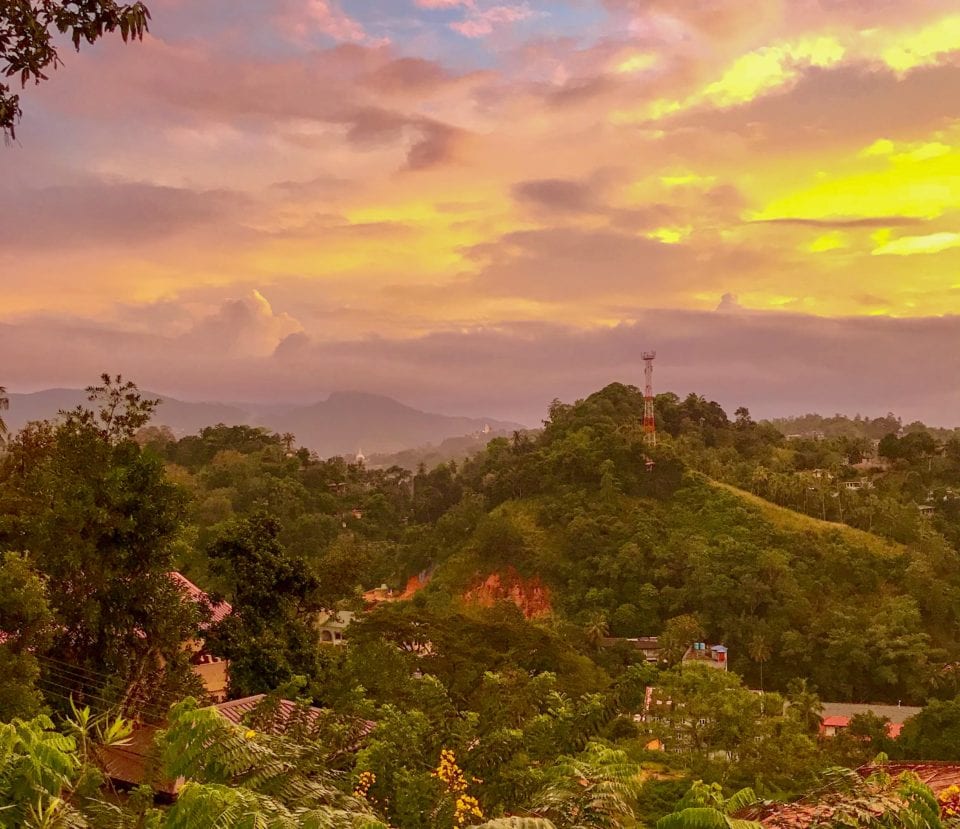
Sri Lanka’s Beach Cities
Sri Lanka is warm year-round but has two distinct monsoon seasons. The Yala monsoon affects the south and the west coast from May through August. Remember, it’s sweltering during the summer months on the equator. The northeast monsoon peaks December through February. We offer beach suggestions around the island so you should be able to find clear weather and calm seas. Avoiding monsoons will also help you find surf breaks with clean waves that aren’t blown out by the storms.
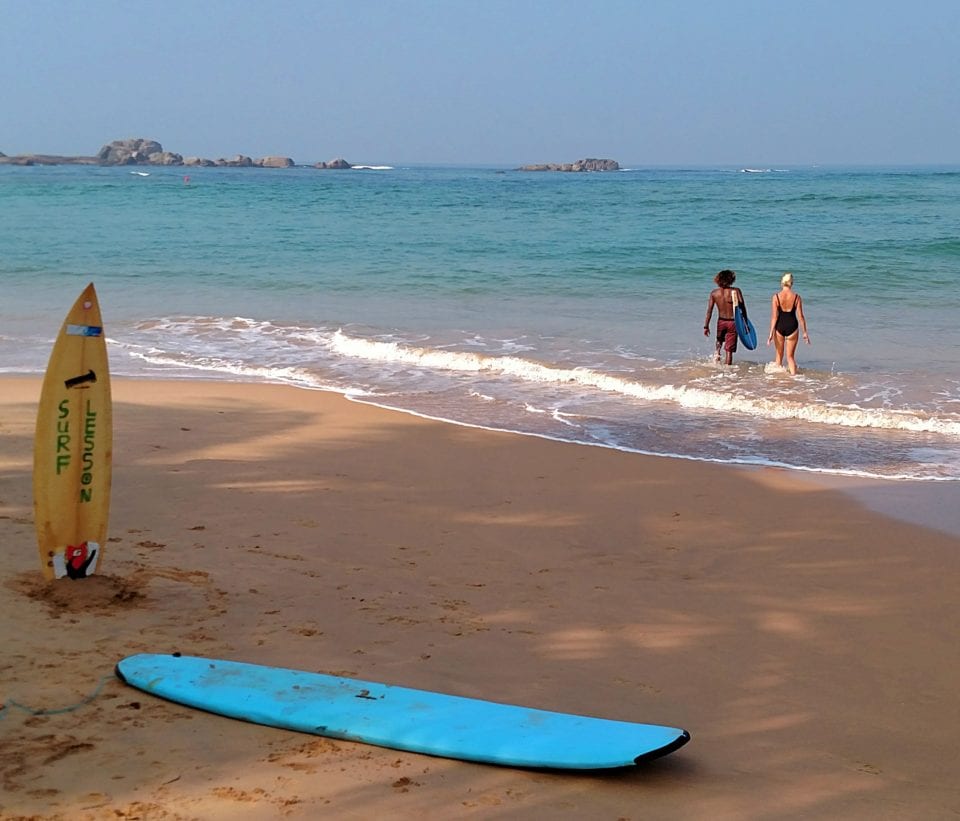
Kalpitiya
Kalpi-what now?! Yeah, that’s generally most people’s reaction when we tell them about Kalpitiya, a little authentic fishing town in Sri Lanka’s northwest. For your average traveler, Kalpitiya doesn’t even pop up on their radar- let alone make it on to their list of must-visits in Sri Lanka. But for adventurous travelers and lovers of adrenaline sports? You better know what’s happening in this teeny weeny corner of the Indian Ocean.
Kalpitiya is to kiteboarding what Arugam Bay is to surfing. The village is surrounded by sandbars, filled with flat water lagoons, and enjoys two reliable windy seasons throughout the year- making it the ideal place to practice (or learn!) kiteboarding. In fact, Kalpitiya’s natural surroundings are so perfect for watersports that it was picked to host an epic freestyle kite competition from the KTA (Kiteboard Tour Asia) earlier in September. Seriously, if you’ve ever thought of dipping your toes (sorry, pun totally intended) in the world of water sports, Kalpitiya is the place to do it.
Aside for the action-packed kiteboarding scene, Kalpitiya offers oodles of other outdoor adventure activities- like diving at Bar Reef (which is actually the largest reef system in all of Sri Lanka) and paddle boarding down the mangrove-lined rivers. If you’re the sort of traveler that values time in nature, peace, and quiet, and a look at what the local culture is really like, Kalpitiya should definitely be on your Sri Lanka hit-list.
Travel tip: When you first glance at the map, it can look like Kalpitiya is pretty out of the way. Which…. ermm… it kinda is. But if you play it smart and combine your trip to Kalpitiya with a visit to the nearby Wilpattu National Park and the ancient city of Anuradhapura, you’ll have yourself a super cultural, adventurous, and unique itinerary.
Kalpitiya written by Grace Austin of Extreme Nomads. Instagram @extremenomads
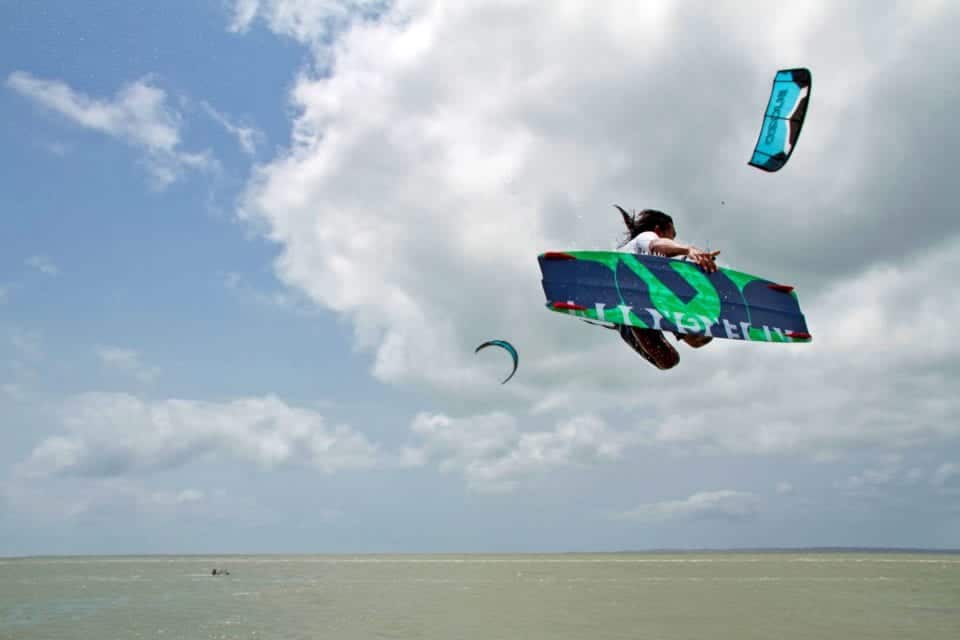
Hikkaduwa
I spent a much-too-short week in Sri Lanka on a visa run during an extended stay in India. Following a few days in Galle and a side trip to Unawatuna, I made my way to Hikkaduwa for a few days of relaxation before heading back to the airport. Hikkaduwa was a surfer’s paradise in the 70s, and today it’s one of the country’s most popular – and developed – beach destinations since it’s only about 100 km south of Colombo. (It seems especially popular with Russian tourists – I noticed most menus and signage are in both Russian and English). My stay was particularly enjoyable because the 1-km strip of beach was relatively empty that February – I easily found a beach chair every day, and I had unobstructed views of the ocean. I booked a last-minute room at a simple little guest house that was just a short walk inland, but there is a mix of budget and higher-end properties lining the beach as well.
Even though I didn’t do much more than nap and read during my time in Hikkaduwa, you can snorkel or scuba dive, rent a jetski or bike, check out the sea turtle sanctuary, or explore the inland lakes by canoe. There also are plenty of restaurants to chose from – featuring various cuisines and price points – both along the beach and the main road through town, and if you’re looking to party, there’s a vibrant club scene (I opted for relaxing Ayurvedic treatments in the evening). Or if you want a more meaningful experience, you can pay your respects at the memorial honoring local victims of the 2004 tsunami.
Travel tip: Colombo’s international airport is small, but you can purchase a SIM card for your visit at a kiosk outside of baggage claim.
Hikkaduwa written by Brianne Miers of A Traveling Life Instagram @brimiers

Unawatuna
Unawatuna is the beautiful beach paradise located on the south of Sri Lanka. It’s a place that’s suitable for all kinds of travelers, including families, groups of friends, couples and solo backpackers. It offers something for everyone, and it’s personally one of my favorite places in all of Sri Lanka.
Unawatuna offers you to the chance to snorkel through crystal blue waters, swim with turtles in the sea (both baby and gigantic turtles), dine on the beach under the stars, and swing on the iconic coconut Dalawella beach rope swing. Add in breathtaking sunsets, and you’ve got an amazing destination.
Lastly, a visit to Unawatuna means you can visit the Dog Care Clinic (the only one of it’s kind in all of Sri Lanka). You’ll get to visit cute puppies and dogs who have been rescued throughout the whole country. It’s a heartwarming experience. If you love turtles too, then you can visit the turtle sanctuary and visit rescued turtles there too. Whatever you decide to do whilst there, Unawatuna will not disappoint!
My top travel tip for Sri Lanka: If you want your own freedom in travel and to experience off the beaten track destinations, then rent out your own tuk-tuk.
Unawatuna written by Cazzy Magennis of Dream Big, Travel Far, Instagram @dreambigtravelfar_type1travel
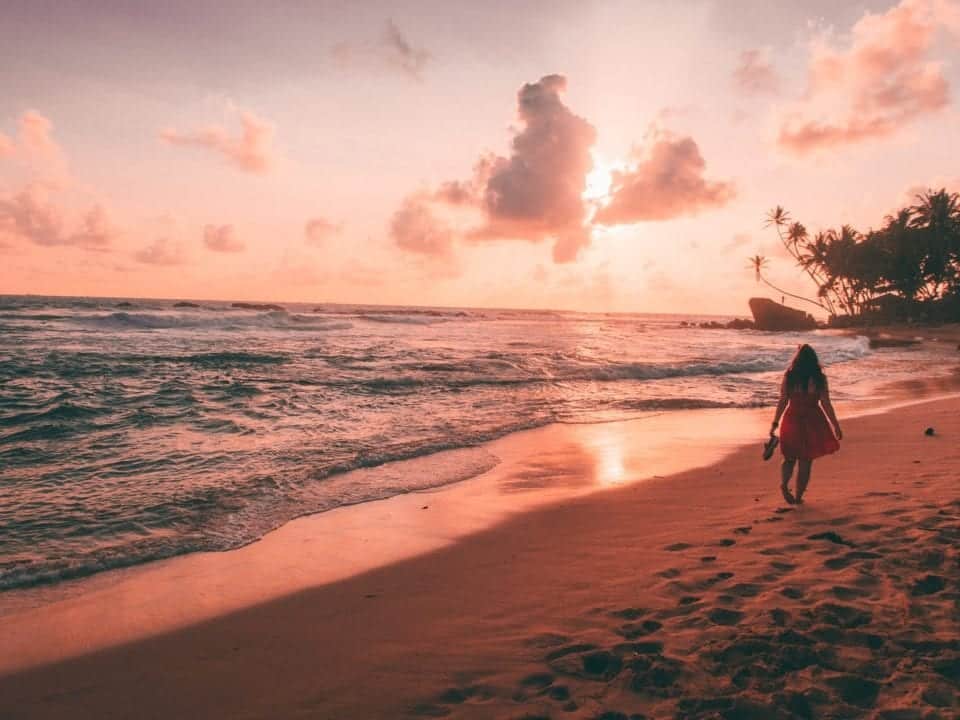
Weligama
Weligama, on the South Coast of Sri Lanka, is the perfect place to go in the country if you want to learn or brush up on your surf skills. The waves in Weligama bay are perfect for beginners, but if you paddle further out, there are some bigger waves for the more advanced surfers. Plus, there are over 30 surf schools within a 500m radius in Weligama, so there’s no shortage of professional lessons for those wanting to learn. If you need to refuel your appetite after surfing, there are many yummy restaurants to go in Weligama. Check out Hangten Rooftop Restaurant across from Weligama Bay, where you can enjoy a delicious and healthy meal, and watch the surfers below.
Weligama is also positioned in a great location, in the middle of many of the main attractions of Sri Lanka. Popular Mirissa and Galle are only a half hour drive away, and Udawalawe National Park can be done as a day tour. Weligama has a number of accommodation options ranging from $7 guesthouses to luxury villas. Wherever you stay, the sunsets in Weligama never fail to disappoint, and there are a number of secluded beaches to enjoy it from in Weligama. If you want to learn to surf and enjoy the beauty of Sri Lanka, Weligama is the perfect place to go.
Weligama written by Lora Pope of Explore with Lora. Instagram @explorewithlora
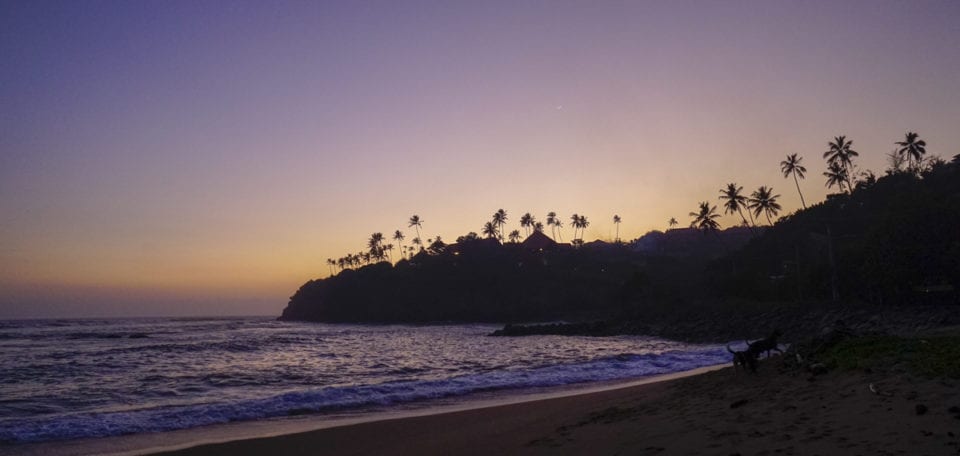
Mirissa
Mirissa in Sri Lanka is a must do place to visit on your trip to Sri Lanka. First off it has a stunning beach lined with great beach bars and restaurants and has some of the best sunsets of all the southern beaches. The vibe is very laid back and friendly, and there’s a great mix of locals, backpackers, and families. In terms of things to do, it’s the top spot in Sri Lanka if you’re looking to do whale watching – you can spot majestic whales out in the Indian Ocean between November and May. There’s a variety of different companies offering tours, so it pays to do your research.
Once you’ve had enough of the main beach, head on over to Secret Beach which is a tiny secluded cove that local tuk-tuk drivers will know about. They’ll drop you on the main road and then it’s a ten minute or so walk down to the gorgeous beach that has a bar and coconut sellers. It’s not so ‘secret’ anymore, but still worth visiting. If you’re into surfing or bodyboarding, then Mirissa is a great spot to catch some waves, and there are plenty of places to rent boards or take lessons if you’re a beginner.
Finally, Mirissa is also a great place to base yourself for a visit to nearby Unawatuna or Galle – it’s easy to zip between these places on a tuk-tuk for a day trip.
Travel tip: the roads in Sri Lanka are not in a great state and can be very winding so allow plenty of time to get between destinations!
Mirissa written by Kylie Gibbon of Our Overseas Adventures. Instagram @ouroverseasadventures
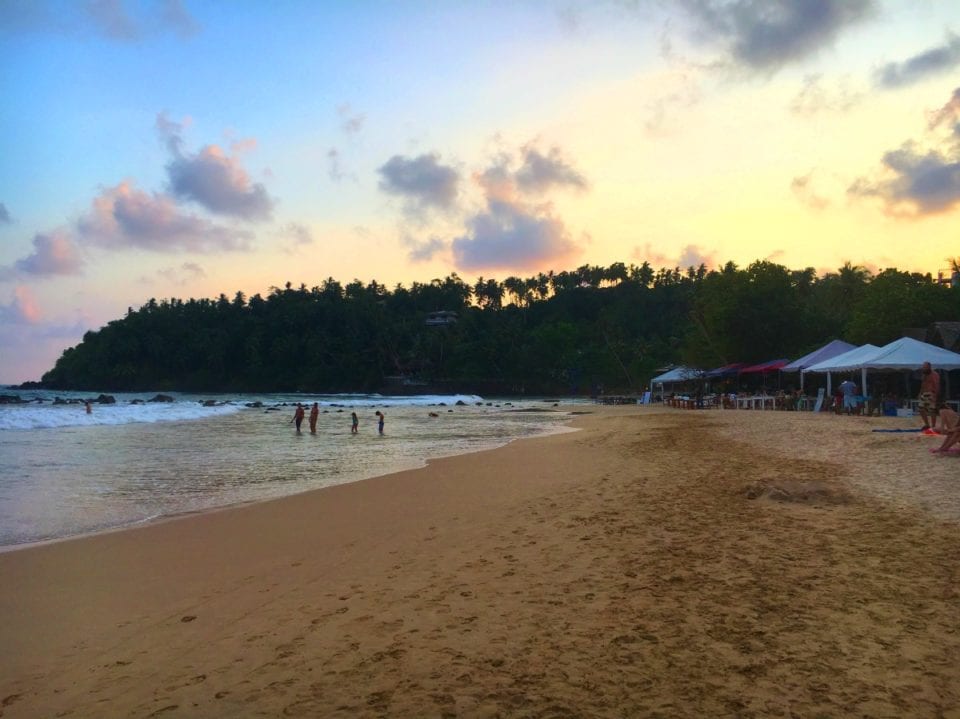
The Train from Colombo to Matara
One of Sri Lanka’s delights is unquestionably the train travel. With views of paddy fields, the Indian Ocean, tea estates and village life as the warm air ruffles your hair and you happily engage with chatter with locals traveling, it’s easy to understand why! There are, however, plenty more ways to experience the joy of train travel in Sri Lanka than the now over-Instagrammed tea train to Ella.
Heading to the south coast for a surf break we scrambled aboard the train from Colombo to Matara. This is the same line as goes to Galle – only most people get off at Galle, missing the best views. The line itself has made history – and seen its fair share of tragedy too as in 2004 a whole train was swept off the tracks by the Christmas Tsunami that destroyed these tracks that lie just a few hundred meters from the ocean’s edge. And that’s part of this (now fully restored) journeys charm: once the hubbub of suburban Colombo fades into the distance, it is replaced by views of the Indian ocean and swaying palms, as the train heads steadily south.
Many take this beautiful journey south to Galle, but the best part is actually after that. Not only because most of the passengers clamber off, allowing you to take up window seat or a spot next to an open doorway, but also for the best views out onto Sri Lanka’s beaches past Ahangama and Weligama. Staying on is well worth it.
Travel Tip: Train travel in Sri Lanka is a much easier affair than in neighboring India; you won’t need to navigate wait-lists or ticket reservations. Buy tickets the day of travel at the station, but just make sure you turn up plenty of time before your train (a couple of hours). For this route, we recommend getting a 2nd class ticket – ask around for where the 2nd class carriages arrive on the platform as you’ll have a few minutes to face the surge of people vying for a spot on these crowded trains. Travel outside of commuter times as this route is popular for many traveling to Colombo for work each day.
The Train from Colombo to Matara written by Ellie Cleary and Ravi Rane of the Soul Travel Blog Twitter @soultravelblog
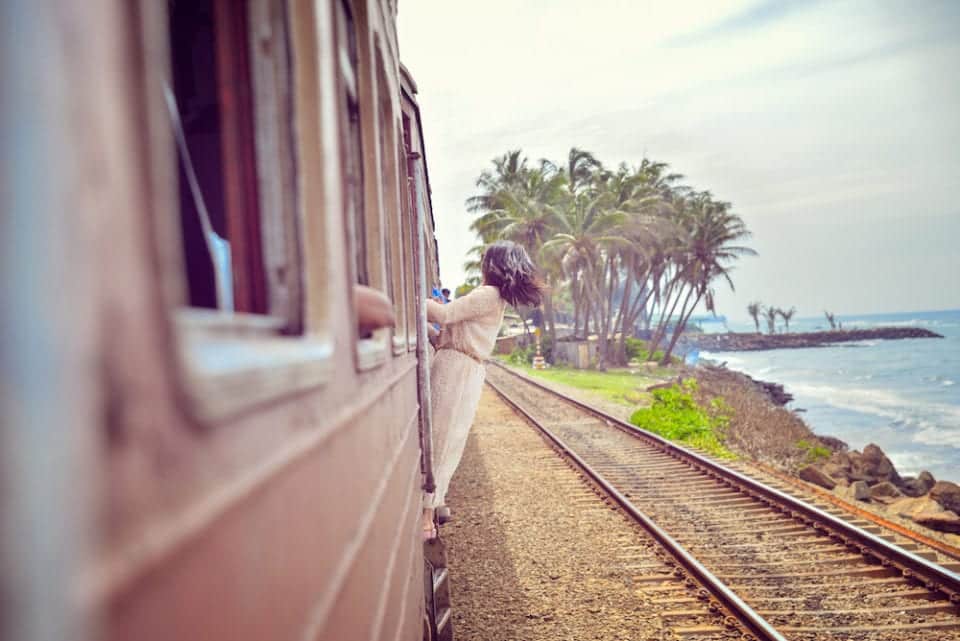
Hiriketiya Beach
We spent three weeks travelling around on the search for the perfect beach the country had to offer. Luckily, we found Hiriketiya; a small bay sat in between Dikwella and Tangalle on the South Coast. Hiriketiya is one of those beaches which hasn’t been ruined by tourism and still has an authentic appeal.
I found out about this beach through a local on Instagram who told me this was the perfect slice of paradise anyone could hope to find in Sri Lanka, and they were right. We were absolutely gobsmacked at this gem of a place with the beautiful and perfect horseshoe bay, complete with a mixture of calm waters and waves further out for the surfer within.
We loved this beach for the chilled vibes and for the awesome bars and restaurants which lined the beach. The other tourists were different to the rest we saw in Sri Lanka, although there was a mix of people from families to backpackers, to couples and hippies, everyone seemed similar for their love of a chilled, perfect beach to spend their days in Sri Lanka.
TIPS: The locals are very friendly, and most speak good English, but we found the people in Tangalle and Hiriketiya to be the nicest out of anywhere we visited as their hospitality is exceptional. We couldn’t walk down the street without everyone wanting to say hello to us.
Hiriketiya Beach written by Annabel Symonds of Londoner in Sydney. Instagram @thelondonerinsydney
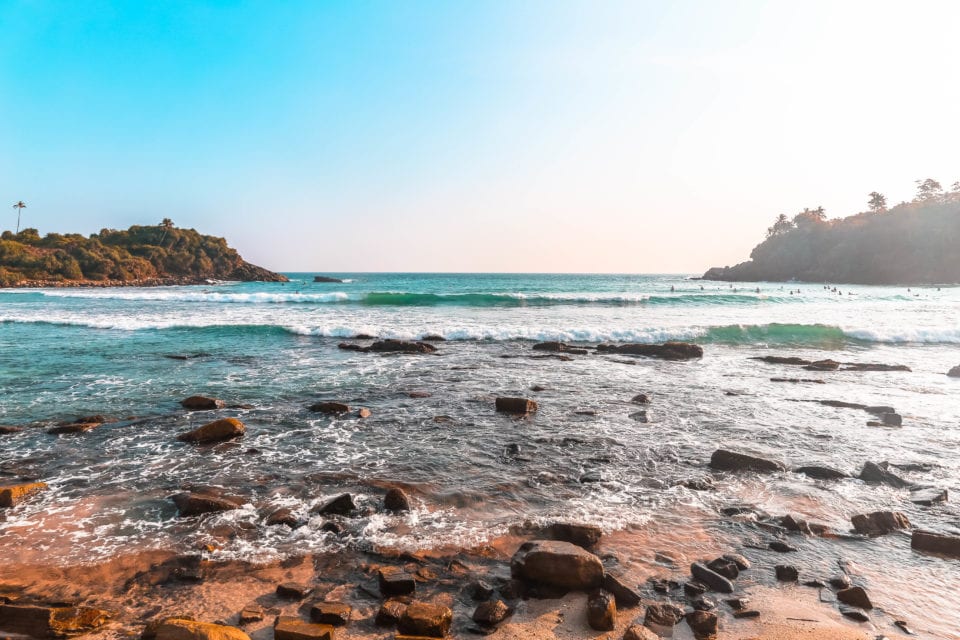
Arugam Bay
On the east coast of Sri Lanka lies the sleepy town of Arugam Bay, or “A-Bay” as many people refer to it. The town has an eclectic mix of cultures, from the more conservative local Muslim community to the hippy vibe from all of the foreigners coming to the area to surf. The pace is slow in A-Bay, and it is easy to lose track of time while you unwind on the beach or lazily read your book in a hammock.
You can certainly chill out in Arugam Bay, but there are also lots of other activities to do. The biggest one is to surf. The best spots to catch a wave are Main Point, Peanut Farm, Elephant Rock, Whiskey Point, and Panama. If you’ve never surfed before, it’s easy to find a surf shop along the main street in Arugam Bay that will take you out for some lessons.
If you haven’t yet gone on a safari in Sri Lanka, you can easily rent a scooter in Arugam Bay and drive 45 minutes south to Kumana National Park or go slightly inland to the smaller Lahugala National Park. A scooter is also a fun way to get to many of the beaches listed above and to get to nearby Kudumbigala Monastery. Renting a scooter is about 1000 LKH ($8) a day and, because A-Bay is so sleepy, there isn’t too much traffic so getting around on it is really easy!
Tip for traveling Sri Lanka: Don’t let the small size of Sri Lanka fool you! Distances can take a really long time to travel, especially in the north, so don’t over commit to too many activities around the island. Two weeks, at a minimum, is a good amount of time to see some of the main highlights.
Arugam Bay written by Eleonore Lore Jones of Eleonore Everywhere. Instagram @eleonoreeverywhere
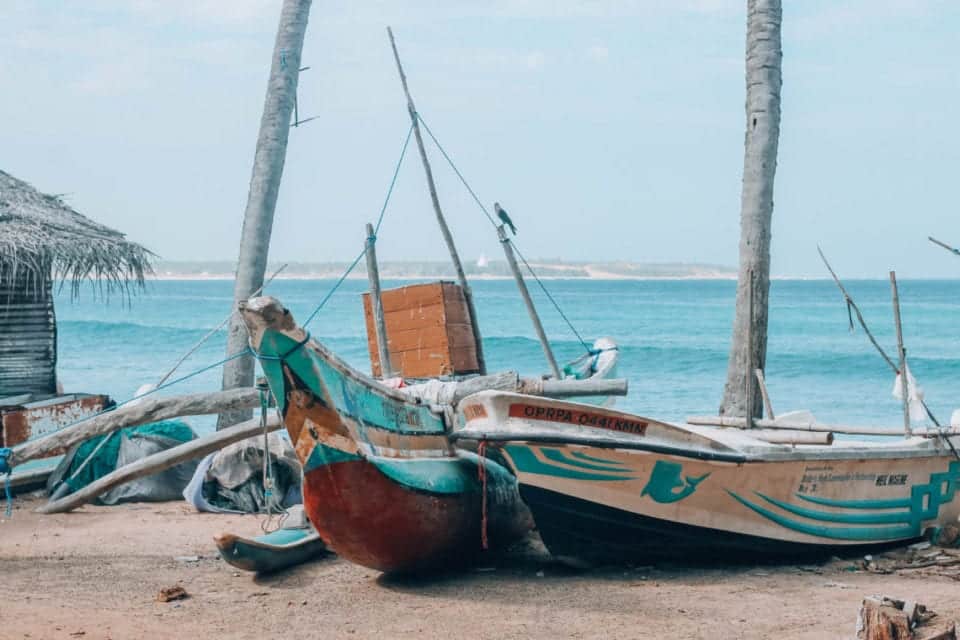
Trincomalee
Trincomalee is a beautiful, small town on the east coast of Sri Lanka that boats some of the best beaches in the country. The east coast is much quieter than the south of Sri Lanka, which is the perfect reason to visit. Motorbikes can be rented cheaply from the town of Trincomalee (1500 LKR per day), which allows the freedom to go and explore the secluded beaches nearby. Check out Nivali beach, which has beautiful white sand to relax on for the day. The main beach in the town of Trincomalee is also a great place to hang out. Visit Fernandos, a laid-back bar, and restaurant offering seats right on the beach.
During the high season (April-September) whale watching is a very popular activity in Trincomalee. For the adventurous, dive shops in Trincomalee even offer the option to go snorkeling with blue whales. The ocean surrounding Trincomalee is beaming with underwater marine life. Head to Pigeon Island for some of the clearest snorkeling in Sri Lanka, where you can swim along reef sharks and sea turtles. Trincomalee is also one of the best spots to go diving in Sri Lanka, offering several colorful reefs and shipwrecks. Whether you want to relax on the beach or explore the underwater world, Trincomalee is an excellent addition to any Sri Lanka itinerary.
Travel tip: Sri Lanka has a tropical climate, with two different monsoon seasons, affecting different parts of the island at different times. This is actually a positive because it means it’s dry somewhere on the island at any time of year. From October to March the South Coast is in season, and from April to September the season shifts to the East Coast.
Trincomalee written by Lora Pope of Explore with Lora. Facebook @explorewithlora
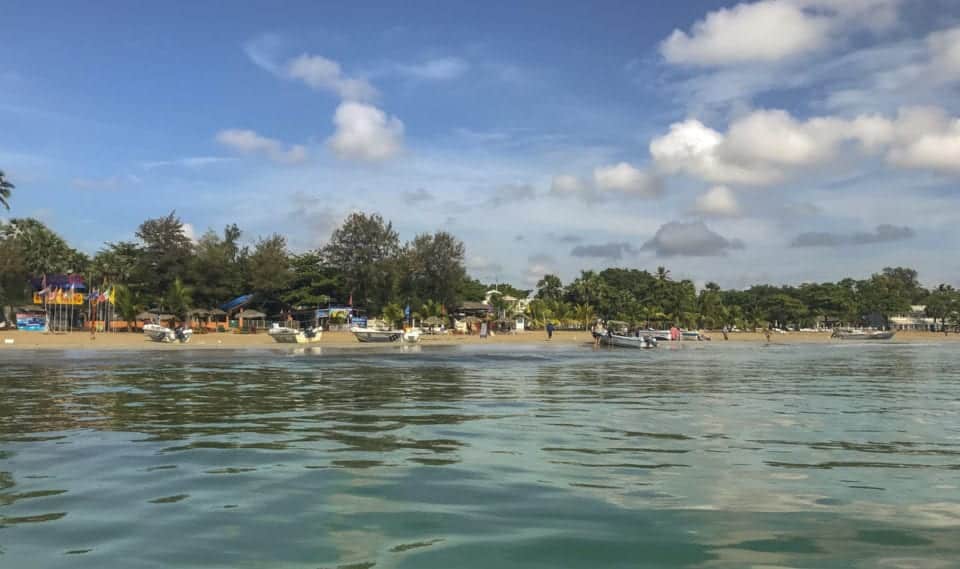
Sri Lanka’s Mountain Towns
Sri Lanka has one primary mountainous region in the south-central region of the island. Pidurutalagala is Sri Lanka’s highest point at 8,281 ft, but you can’t go there. It’s an ultra-high security zone since it houses important communication towers, but there are lots of reasons to head for the mountains. Tea plantations dot the highlands. Beautiful train routes snake along the slopes. Sleepy mountain towns offer an escape from the heat and hustle of the coast. It’s hard to say if the best views are from Adam’s Peak or the cliffs at World’s End, but you’ll have to go to find out for yourself.
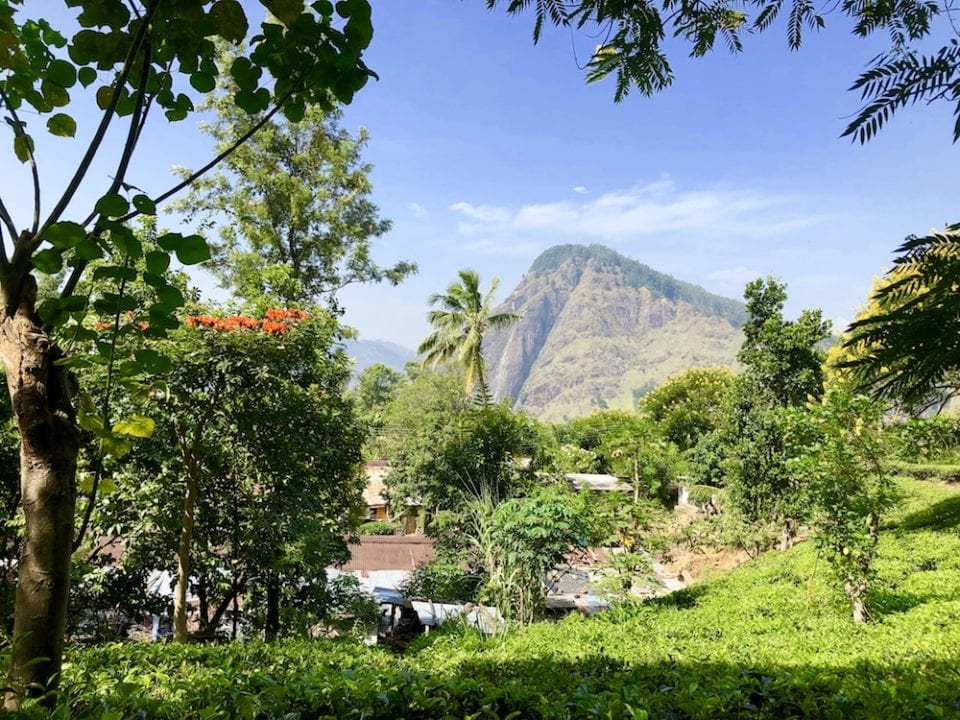
Nuwara Eliya
Nuwara Eliya is a colonial style city found in the hills of Central Sri Lanka. It is best known for its tea plantations and has the nickname Little England. It really does feel like you have stepped into another country as you enter, many of the homes here have English style gardens, most of the buildings retain their old colonial features, and newer builds still maintain the same style.
If you make it to Nuwara Eliya (you must!), make sure to go on a tea plantation tour. This is the specialty here, and Ceylon tea is world famous. There are several companies offering tours, and they offer lots of tasters along the way. If you know your teas, make sure to track down the world’s finest orange pekoe tea grown here.
Beyond tea plantations, Nuwara Eliya offers beautiful walks, lakes, and waterfalls. Specifically, make sure you head to Horton Plains National Park and find ‘Worlds End’ – a sheer cliff drop and an incredible view!
Top Tip for Sri Lanka: Don’t just visit one location, go on an organized trip with either a group or arrange a private driver to take you all over the country, don’t just sit on one beach for two weeks!
Nuwara Eliya written by Sion Walton of The Globe Trotter Guys Instagram – @theglobetrotterguys

Ella (and the Train to Kandy)
Our can’t miss destination for Sri Lanka is the tiny tea mountain town of Ella! We visited 7 cities on a month long trip in Sri Lanka, and Ella was, without doubt, the standout highlight… and it doesn’t even have a beach (and we are beach lovers!). When I say mountain, think not of cool weather and snow, certainly not in the summer anyhow! Instead, there are warm days and cooler nights for sleeping; with abundant sunshine lighting up the verdant green tea plant covered mini-mountains of around 1000 m elevation.
For such a small (one main street) town Ella certainly has a lot of sightseeing! And the sightseeing is conveniently close and can be covered via tuk-tuk tour within 1-2 days! Highlights for us included the view from mini-Adam’s Peak, a very minimal hike of just half an hour for gorgeous views; the nine arches bridge to view the train crossing; and the Uva Halpewatte Tea Factory which was a fascinating learning experience even on a non-production day.
Further afield from Ella you can find more hikes and views in the area such as Lipton’s Seat approx an hour’s journey by train to the Haputale station. This train ride is touted as one of the most scenic in the world and is a recommended sightseeing activity in itself (and is where people get that amazing hanging out of a train window/doorway photo that you see all over Instagram!).
Travel Tip: However, if you are hoping to get that classic photo and enjoy those beautiful views, we have one tip for you. Try to take the train not from Ella’s main station but instead from Badulla or Kithal-Ella as those who get on to the train first quickly fill the available window and doorway seating of the second class carriages and do not yield them for anyone! You definitely won’t get one of these coveted spots coming back from Haputale to Ella as this journey starts in Kandy about 4 hours earlier, so the train back is MEGA crowded! Don’t take first-class either as the windows and doors in this carriage are sealed.
Ella (and the Train to Kandy) written by Erin Hardie of Down Bubble Instagram – @downbubbletravels
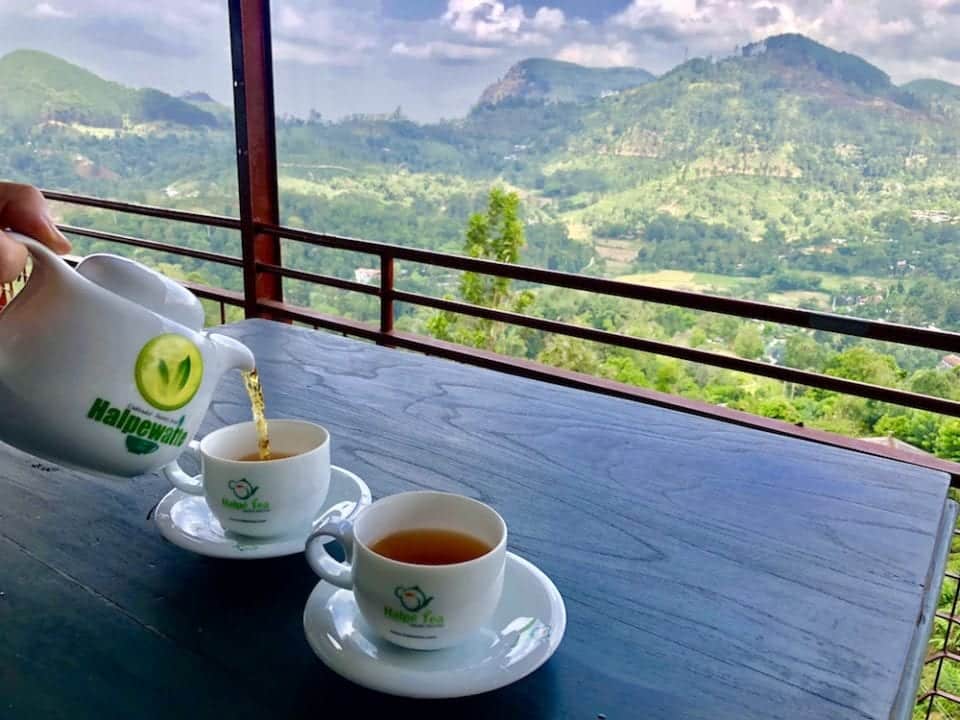
Handunugoda Tea Estate
Handunugoda Tea Estate also known as the Virgin White Tea estate is a family owned plantation of planter Malinga Herman in Tittagalla, Ahangama. Interestingly, this is the only tea estate that is so close to the sea in the whole world. It lies 160 km from Colombo; 24 km from Galle Fort; and 6 Km inland from the main highway nestled between the evergreen forest and the vast Indian Ocean.
The total Handunugoda estate is spread over 150 acres, out of which 75 acres produce tea and the balance 75 acres produces rubber, cinnamon, and coconut. The estate is not a mass producer of Tea but produces the choicest collection of 5 categories of tea (Black Tea, Oolong tea, green tea, white tea, and Herbal infusions) that matches the International Standards.
The Virgin white tea estate produces Virgin white tea, completely untouched by hands. The white tea leaves here are harvested, following the Chinese rituals. In the ancient era, the Chinese emperor Tsong and Tsang used to deploy the virgins to pick the leaves wearing white silk gloves, with a golden scissor into a golden bowl. The virgin white tea never touched the bare skin until it touched the lips of an Emperor. This high tea was only for the emperor and served to the rulers and dignitaries. The Handunugoda estate still mimics this tradition except that the virgin concept now applies only to the tea and not to the pluckers.
Sri Lanka Travel Tip: Handunugoda Estate tours take 1.5 -2 hours and run between 8:00 am- 4:30 pm
Handunugoda Tea Estate written by Suruchi Mittal of All Gud Things Instagram @suruchimittal
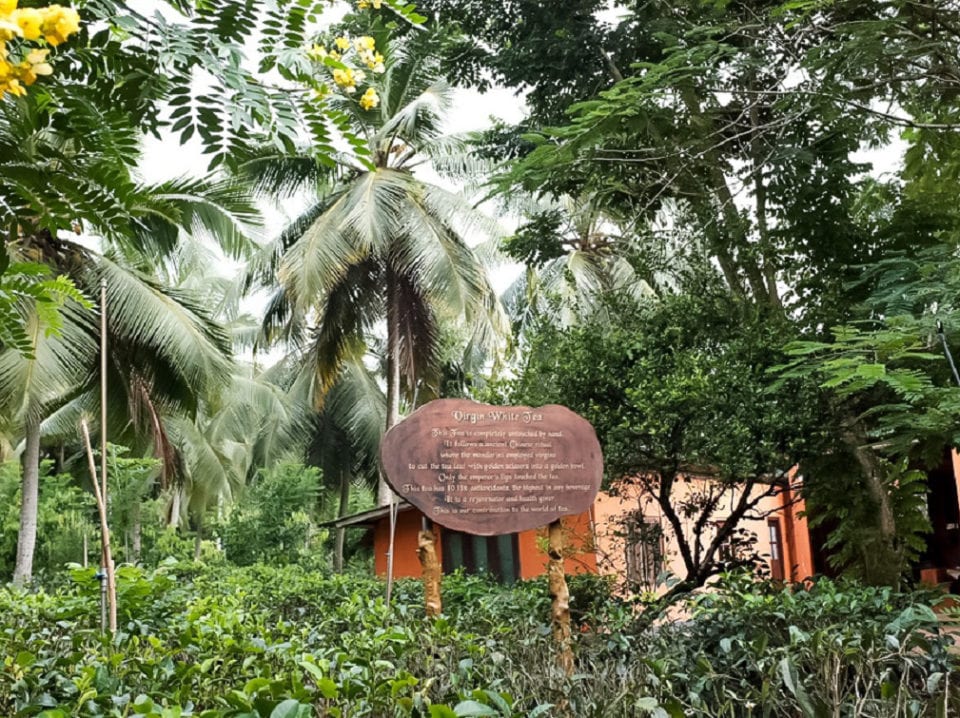
Sri Lanka’s Cultural Highlights
Sri Lankan kingdoms flourished in the central highlands Long before European traders dock in Colombo. The First Kingdom lasted from 400 BCE to 1100 CE centered about the sacred city of Anuradhapura. From 477 to 495 the rouge King Kasyapa relocated the capital to Sigiriya Rock, but that experiment didn’t last long. The second kingdom was established when King Vijayabahu I united the island under local rule and built Polonnaruwa in 1070 CE. Kandy was the final Sinhala Kingdom where the kings ruled in the mountain highlands from 1590 to 1815. Sri Lanka’s Cultural Triangle contains these historical sights and more. Combine this rich history with colorful Buddhist and Hindu traditions and the ancient wisdom of Ayurveda, then mix in the splendor of the Dutch Fort at Galle and the modern Asian flair of Colombo, and you’ll have a cultural treat to delight any history buff.

Anuradhapura
One of the highlights of our month in Sri Lanka with our toddler was the time we spent in Anuradhapura. Anuradhapura is a city in the North Central Province of Sri Lanka, about 170 km north west of Sri Lanka’s capital Colombo. Sri Lanka has eight UNESCO World Heritage sites, and Anuradhapura is one of them, due to its well-preserved ruins of an ancient Sri Lankan civilization. Historical records show that Anuradhapura was founded in the 5th century BC and it became one of the ancient capitals of Sri Lanka. It’s the largest and oldest of all Sri Lanka’s ancient cities.
Because of its history and importance, Anuradhapura is part of Sri Lanka’s Cultural Triangle. Still today Anuradhapura is one of the great centers of Buddhism in South Asia. Thousands of pilgrims and tourists come to visit each year. The old urban core, now a 10m high mound covered in jungle, is surrounded by over thirty square kilometers of Buddhist monasteries and huge reservoirs. The most spectacular Buddhist monuments are four great stupas, some of which are over 80m high.
The entrance fee to see the ancient city is quite high, $25 per person. It doesn’t seem like a lot, but we were traveling long-term and very low budget. We chose to explore the parts of Anuradhapura that you didn’t need a ticket for and were still impressed. Some people say that by doing this you’re scamming the organization as the entrance fee goes towards maintaining the site, and in hindsight perhaps we should have just paid the fee. Traveling around by tuk-tuk and having a driver show us around made a big difference for us traveling with a toddler. If you aren’t traveling with small kids, exploring the ancient city by bike seems like an awesome adventure.
Sri Lanka Travel Tip: The local food is incredibly spicy. If you’re on a budget and don’t like spicy food, try the kottu. It’s made fresh, and you can ask them not to put any spice in it.
Anuradhapura written by Lisa van den Berg of Flip Flop Globetrotters Instagram @flipflopglobetrotters/
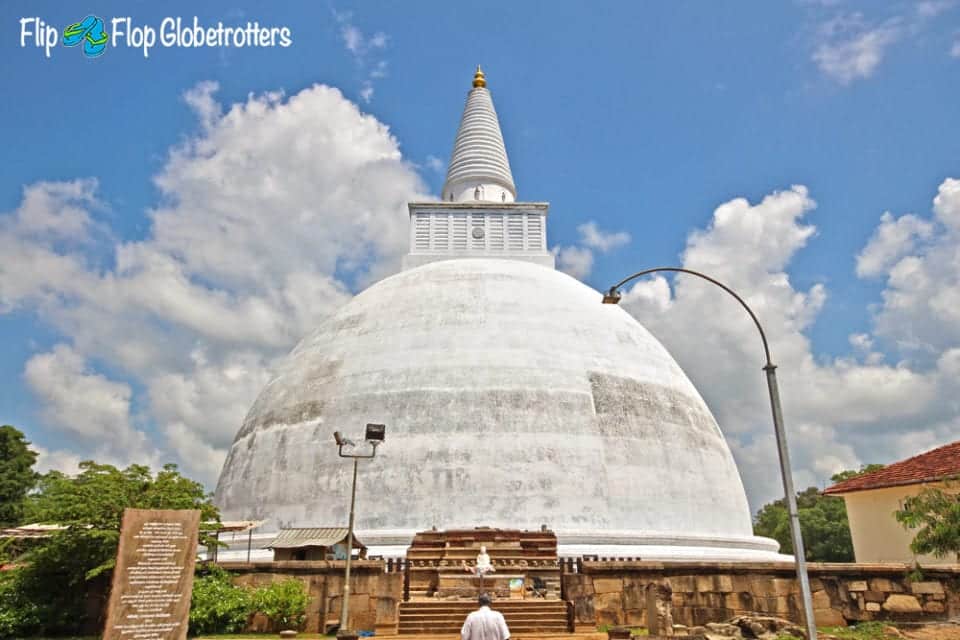
Sigiriya Rock
Sigiriya Rock or Lion Rock, a natural wonder that is the centre of Sigiriya. Geologists have found that Lion Rock is the result of lava solidifying after a volcano eroded away. It allegedly became the seat of power with buildings all around the base of the rock and what archaeologists believe is a temple and meditation platform on the top. On the climb to the summit of Lion Rock, you’ll see brilliantly preserved ancient cave paintings before reaching the final stairs that go between two huge paws. The view from the top is panoramic, and you can see for miles in all directions. It’s a lovely spot to be at sunset. Sri Lankans are rightly proud of Lion Rock. It is to Sri Lanka what Angkor Wat is to Cambodia.
If you want the best view in Sigiriya though, head to Pidurangala Rock next door. This is another huge rock (not quite as high as Lion Rock) and actually allows you to look back on Lion Rock which we think gives this view the edge. It’s particularly photogenic at sunrise.
Top Travel Tip – Download the app “Pick Me”. This is the equivalent of Uber in Sri Lanka and can even be used to organise a car for longer journeys such as Negombo to Kandy and Colombo to Galle for a really good rate.
Sigiriya Rock written by Cat Smith of Walk My World Facebook @walkmw/
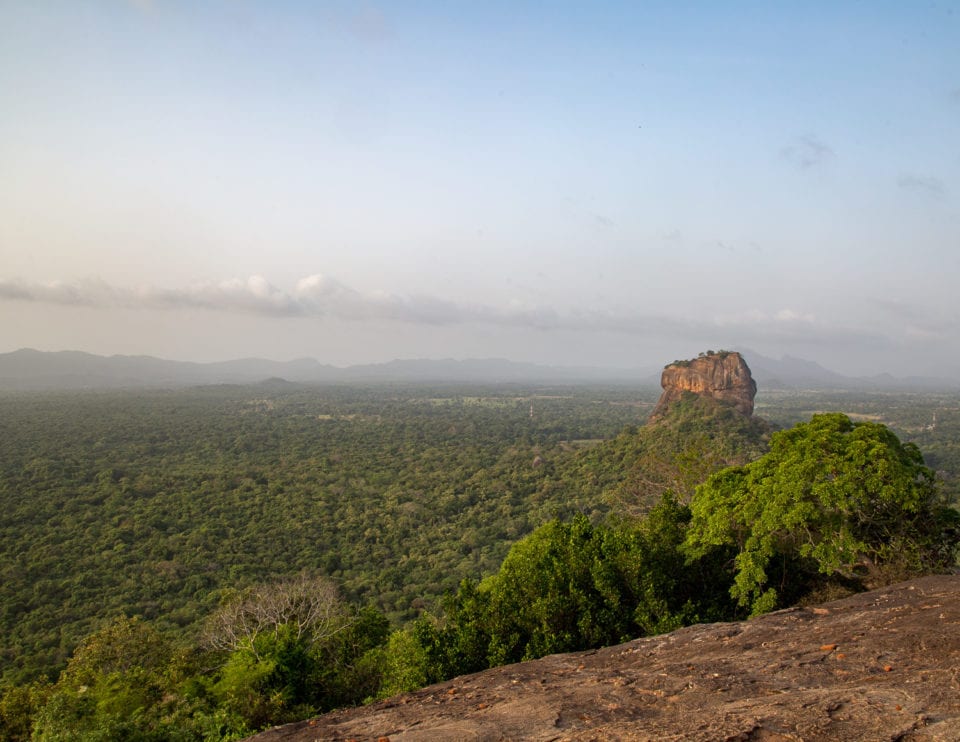
Pidurangala Rock
Hiking Pidurangala Rock is a “must do” activity because it completes the Sigiriya Rock story. You will literally and figurative gain a new perspective on Sri Lanka’s most famous landmark. Kashyapa moved the monks of Sigiriya here when he claimed it for his royal palace. Also, the famous Lion’s Gate faces Pidurangala’s reclining Buddha which has to be more than a coincidence.
Climbing Pidurangala contains the adventure lost on Sigiriya’s staircases. The trail is steep, and you’ll have to scramble to get to the summit, but the views make it all worthwhile. It costs a lot less to climb Sigiriya too. It’s the best $3 you’ll spend in Sri Lanka!
Sri Lanka Tip – Pidurangala Rock shades the trail from afternoon sun making it the perfect place to catch a sunset.
Pidurangala Rock written by Jenn and Ed Coleman of Coleman Concierge. Instagram – @coleman_concierge
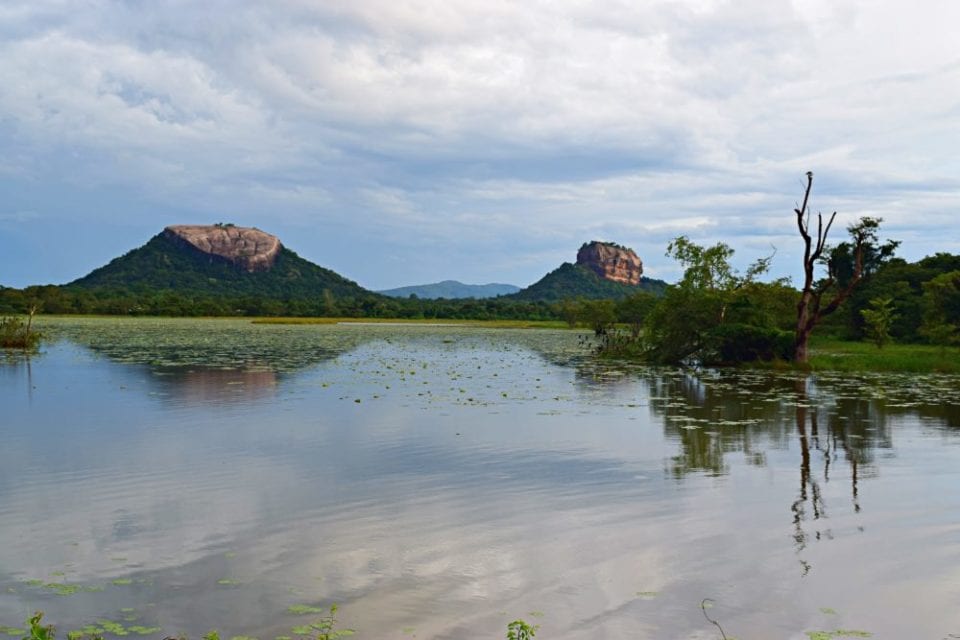
Ayurveda Retreat
After spending a month in Sri Lanka, I can wholeheartedly say that one of my most memorable experiences was my stay at the ayurvedic-driven Mahagedara Retreat. The Sri Lankan wellness hub is a can’t miss experience. It’s located centrally near the famous Lion Rock in Sigiriya. Mahagedara means family home in Sanskrit, a name it fully lives up to as it’s such a welcoming and sacred space.
This haven offers courses on ancient Ayurvedic lifestyle principals that soothe the mind, body, and soul through everything from healthy food, yoga, spa experiences, and getting in touch with nature. Spending time at the sustainable sanctuary was divine. I was able to unwind and simply focusing on my mental, physical, and spiritual health.
The entire experience at Mahagedara Retreat was fulfilling and transformative. I left with a better understanding of the Ayurveda lifestyle and a commitment to fold more of the ancient practices into my daily routine in order to live more fully. I felt restored and balanced and ready to take continue traveling around Asia.
Travel Tip: When traveling to Sri Lanka pick up a local sim card, they’re very inexpensive, and WiFi can be pretty unreliable. At Mahagedara Retreat the WiFi doesn’t reach all of the rooms, which actually helps you connect with nature, but sometimes you just need to have that internet connection.
Ayurveda Retreat written by Lola Méndez of Miss Filatelista Instagram @missfilatelista
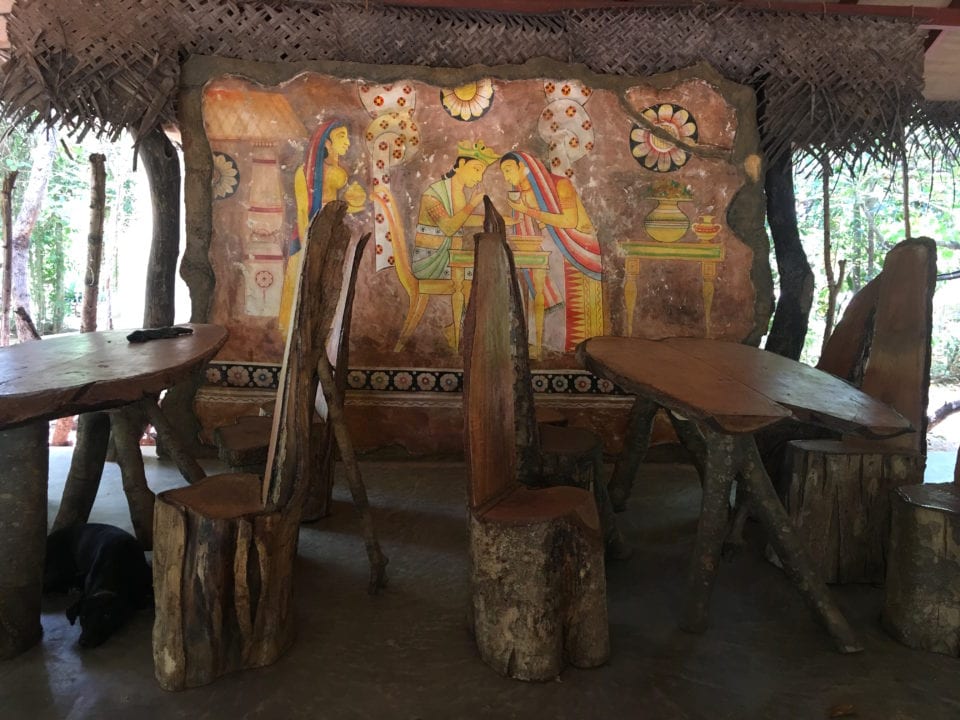
Dambulla Cave Temple
Dambulla Cave Temple (or temples) have been a place of worship for the last 2,000 and will likely continue for the next 2,000 years. Rock overhangs (aka “caves”) shelter the temples from the elements which are part of their astounding longevity. How often do you get to visit a two-century-old site that looks as good today as it did when it was built?
Dambulla Temples are sacred ground. Dress appropriately in conservative clothes that cover your knees and shoulders for both men and women. Wear comfortable shoes for the hike (up a 300′ hill) but expect to take them off before you enter the grounds. Most of all, know where the ticket counter is. There are three entrances to Dambulla, but only the south/lower entrance sells tickets.
Tip – There are no services at the top of Dambulla Cave Temples so plan you water management well. Take water up with you and make sure you go to the bathroom at the bottom.
Dambulla Cave Temple written by Jenn and Ed Coleman of Coleman Concierge Instagram – @coleman_concierge
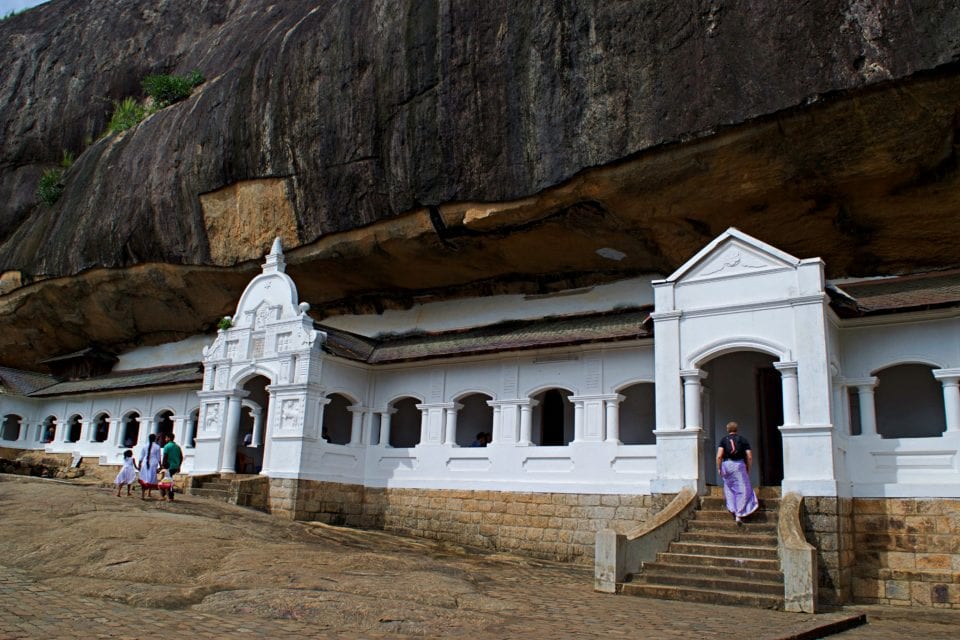
Polonnaruwa
Polonnaruwa was the royal capital of Sri Lanka – the kingdom of Anuradhapura – in the 11th century, but its origins could be traced much earlier to 2nd century BC. The ancient capital was a fortress city to protect itself from foreign invaders. Polonnaruwa was at its highest glory due to three rulers: Vijayabahu the Great, Parakramabahu the Great and Nissanka Malla. These rulers promoted growth and development of agriculture in the province, city planning and architecture, and medicine and medical science.
Before you explore the site, it’s highly recommended that you visit the museum first as the museum gives you an introduction to the ancient city and summarises the historical heritage of the site. It is also helpful to get hold of a map of the site so that you have an idea about the location of each section and the direction on how to get there.
You can either rent a bicycle or hire a driver to explore the site as the ancient ruins are located far from one another. Furthermore, the Polonnaruwa site is quite dry and has very little trees to take shade. Overall, it takes about five hours to explore Polonnaruwa.
Traveling Tips: Due to the dry environment in Polonnaruwa, do remember to bring a bottle of water, wear proper footwear, a hat and put on some sunblock to protect yourself from the heat.
Polonnaruwa written by Kathleen Poon of Kat Pegi Mana: Where Is Kat Going Twitter- @katpegimana
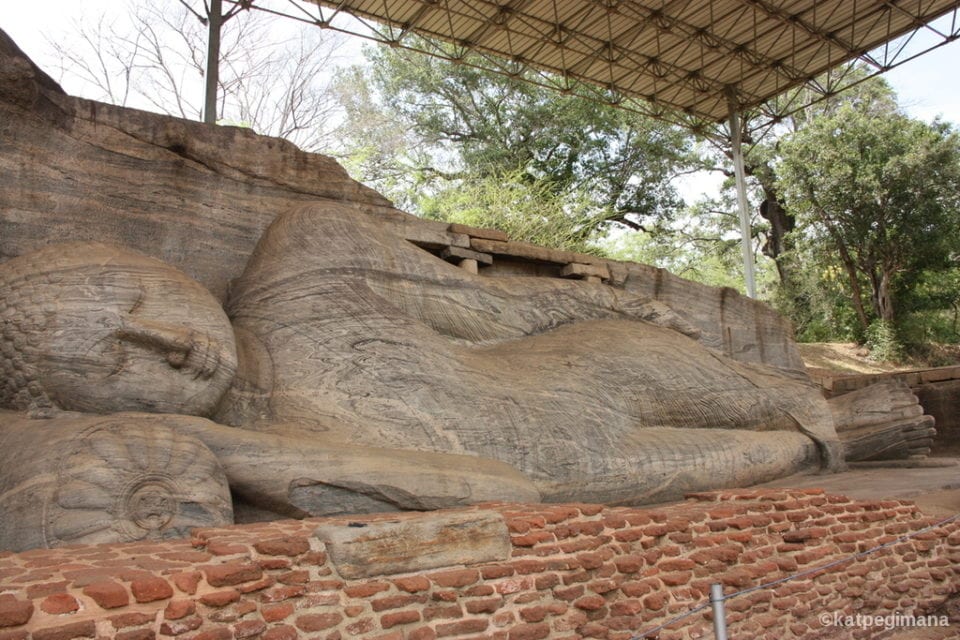
Kandy
The Hill Capital of Sri Lanka sits in the valleys around the misty hills in the central region of the island and is the most revered and respected cities in Sri Lanka. It was the last capital during the era of the great Kings and to this day considered the spiritual heart of the country.
It is a very pretty city that has a central lake and on its shores is the famous Temple of the Tooth, also known as Sri Dalada Maligawa, which is essentially a shrine holding the alleged tooth relic of the Lord Buddha. The relic has played an important role in history and politics, and today it is a place of worship for Buddhists from all over the world. The lake was built by Sri Wickrama Rajasingha, the last King of Kandy who was deposed by the British in 1815.
The city winds around the hills that surround the river, and there is a lot to see including The Royal Palace Complex, Royal Bathhouse, and Summer House and the truly beautiful Botanical Gardens which is the largest of its kind in Sri Lanka and is considered by many to be one of the best in Asia.
Kandy is also a UNESCO world heritage site.
Travel Tip: My tip for Kandy is simply to spend a few days there. We were told it needed nothing more than an overnight stay but upon arrival realized there is quite a lot to see and do. It really does warrant probably three nights as a minimum.
Kandy written by Sandy Papas of Tray Tables Away Instagram @traytablesaway
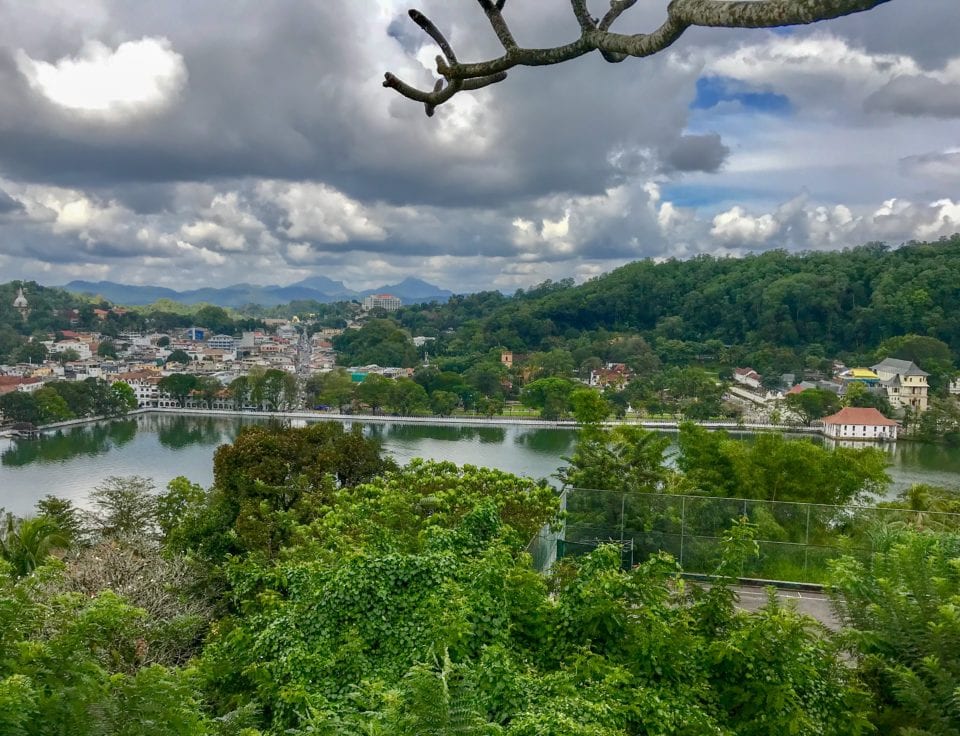
Tissamaharama
The town of Tissamaharama, or Tissa, should be on every Sri Lankan travel itinerary. Tissa is located in the Hambantota District and within the Southern Province.
Tissa has many important historical Buddhist monuments some dated back 2500 years. The most impressive is the Raja Maha Vihara Dagoba. The best time to visit Raja Maha Vihara is at night to see the beautiful stupa illuminated.
A short walk away is Sandagiri Wehera dagoba. This stupa is the oldest in the region and is surrounded by rice fields making it ideal for some beautiful photos. Yatala Wehera dagoba is another stupa in Tissa. A moat filled with lotus plants surrounds it, and there is a small museum filled with ancient artifacts and pottery.
Sri Lanka travel tip: Elephant welfare is lacking in Sri Lanka. Avoid temples that house elephants. If you find yourself with a temple elephant, do not pay to swim or ride them.
Tissamaharama written by Alana Tagliabue of Family Bites Travel Facebook @familybitestravel
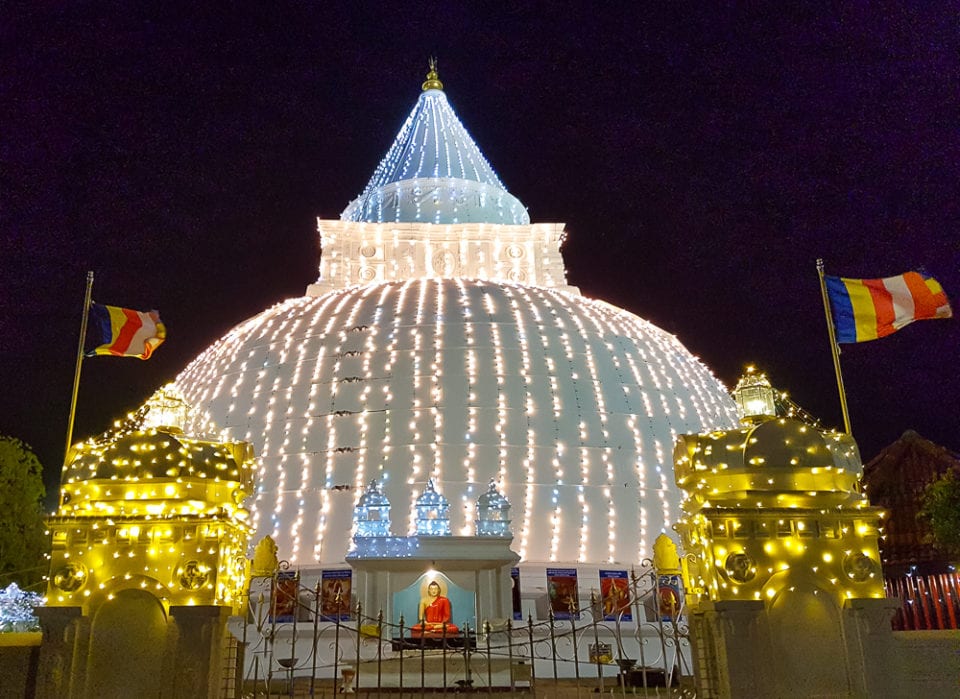
Galle Fort
The ancient fort of Galle is one of Sri Lanka’s most beautiful and vibrant destinations. It was originally founded by the Portuguese in the late 1500s when they stopped on the tropical shores on their way to trade spices and other goods such as ivory, silk, and porcelain. Galle’s position along the Spice Routes soon turned it into a strategic port. The Dutch arrived in the 17th century and extensively fortified the fort building ramparts and bastions.
Today, Galle Fort is a UNESCO World Heritage Site and the largest remaining fortress in Asia built by European occupiers. This colorful history and heritage are visible everywhere within the fort walls as you wander past colonial buildings, historic churches, and old temples. Narrow streets are lined with characterful homes, some of which have been transformed into boutiques, galleries, and restaurants.
What’s especially interesting about Galle, however, is that it’s not just a perfectly preserved tourist destination, it’s a vibrant community filled with people going about their daily business. Just outside the entrance to the fort is Galle International Cricket Stadium, believed to be one of the most picturesque cricket grounds in the world.
Travel Tip: There are some beautiful boutique hotels located within the fort walls. It’s definitely worth splurging for a night or two if you can.
Galle Fort written by Katja Gaskell of Globe Totting Instagram @globetotting

Colombo
Let’s face it, nobody books a holiday to Sri Lanka just to visit Colombo, but it would be a big mistake to write-off Colombo, especially now. The colonial city is having a moment and is set to double in size thanks to a billion-dollar modernization project that will bring big changes.
Take your pick from the key sights – like the Bawa-designed Parliament Building or the National Museum – before hitting the shops. Colombo is hands-down the best place to buy your Sri Lankan souvenirs, from Arcade Independence Square to Liberty Plaza, plus discount shopping at The Factory Outlet, and a sustainable produce store, the Good Market.
The fast-expanding luxury hotel scene is a sign of a city that’s on the up, quite literally: ascend to the rooftop bar at Jetwing Colombo Seven for a sophisticated sundowner overlooking the infinity pool in the swishest neighborhood in town. Then complete your Colombo odyssey with a lip-smacking seafood supper at Ministry of Crab at the Dutch Hospital.
Travel Tip: No matter how you get around Sri Lanka – be it bus, train or private car – you’ll want to download the Pick Me app for your time in the capital and the Western Province. Sri Lanka’s own version of Uber (Uber is also available here) is reliable and cheap, and you can choose from various classes of car, including tuk-tuks.
Colombo written by Jaillan Yehia Savoir There Instagram @savoirthere
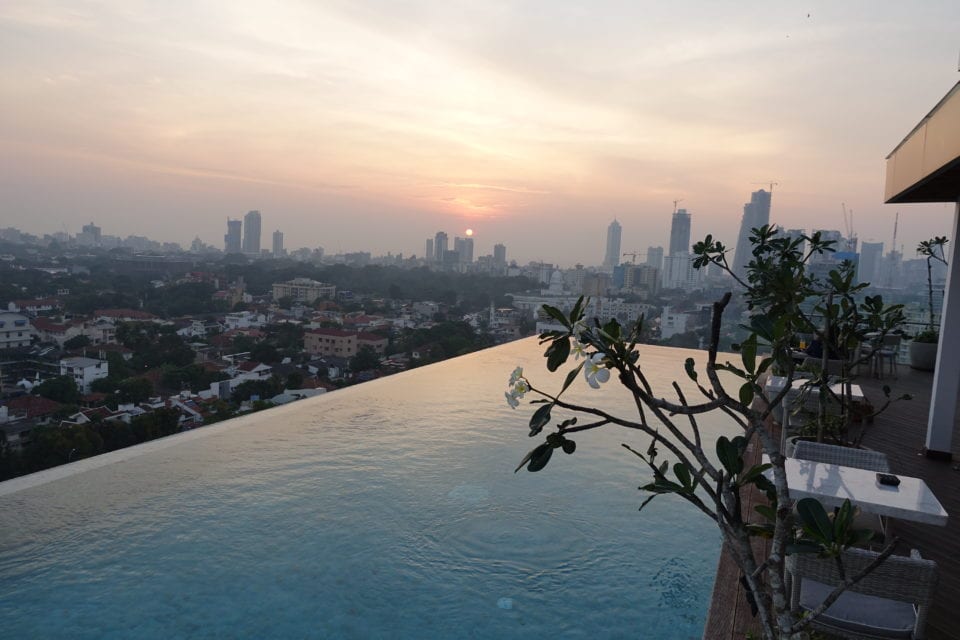
Sri Lanka’s Animal Encounters
Sri Lanka is one of twenty-five biodiversity hotspots in the world as designated by Conservation International. Not only does Sri Lanka has the most biodiversity in Asia but it’s threatened with destruction. The choices you make as an eco-traveler can make the difference. Look out for unethical operations like Pinnawala Elephant Orphanage where they actively breed captive elephants or tours that offer elephant rides. We would recommend taking a safari in one of the 26 national parks. On the mountains and plains, you might see Asian elephants, leopards, and sloth bears. In the ocean, you’ll find dolphins, turtles, and whales. Below is just a small sampling of the amazing animal encounters in Sri Lanka.
Check out our article about how Sri Lanka safaris are saving baby elephants and preserving the species.

Kaudulla National Park
Kaudulla National Park is one of the best places in the world to see wild elephants. Late in the summer, when the central highlands get extremely dry, hundreds of elephants gather in the perennial wetlands of Kaudulla. Here you’ll see elephants just being elephants, which is an experience you’ll never forget.
Elephants are loving, social animals. Observing mom and her babies or two juveniles playing confirms everything you have heard about elephants. They are too intelligent and advanced to be mistreated. We cried with joy watching baby elephants romp on the plains of Kaudulla. We cried again when we returned to Sigiriya and watched captive elephants twitching nervously in their chains. You have your choice of elephant memories to take home with you. Choose wisely, your safari could save baby elephants in Sri Lanka.
Tip – Bring cash with you to Kaudulla. Not all tours package in the entrance fee that needs to be paid in cash at the park which is an hour drive from the nearest ATM.
Kaudulla National Park written by Jenn and Ed Coleman of Coleman Concierge. Instagram – @coleman_concierge
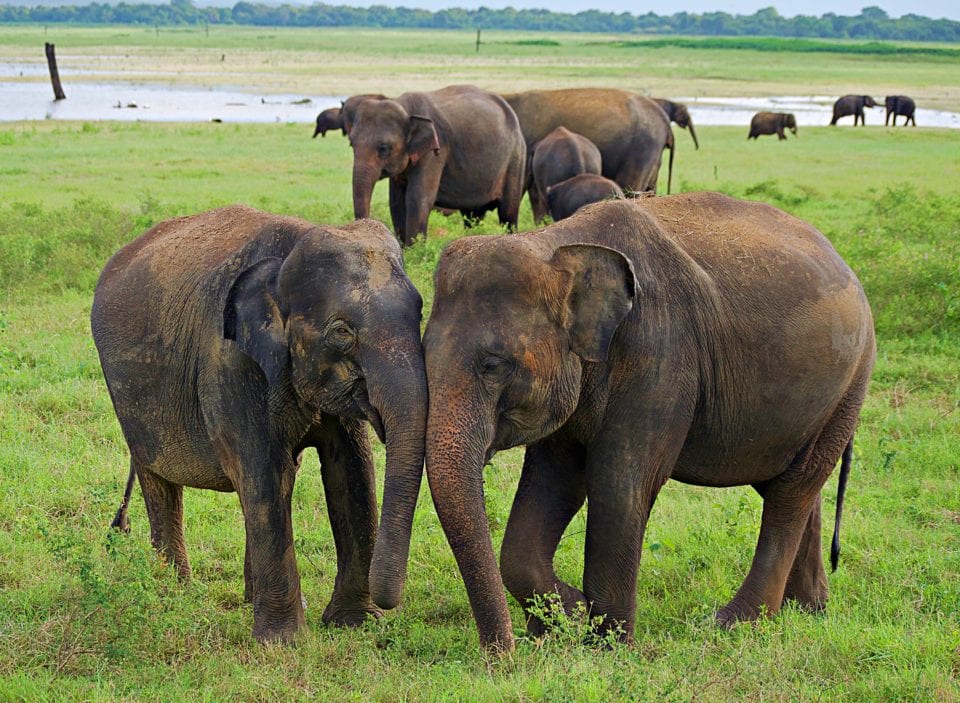
Minneriya National Park
Although the majority of visitors to Sri Lanka do their wildlife spotting at the more famous Yala and Udawalawe National Parks, it’s Minneriya that is a must-visit for elephant enthusiasts. The park centers around the vast Minneriya tank, built by Mahasena over 1,800 years ago. Although it was abandoned not long after it was constructed, it is one of the few places in the country that regularly survives the drought of the annual dry season. I suppose that’s why, despite its relatively small size, Minneriya is one of the best places in the country for wildlife spotting. Elephants, deer, langur monkeys and sloth bears can all be found here, making the most of the permanent water supply.
However, it is elephants that are the park’s main attraction. Minneriya forms part of the elephant corridor that joins both Kaudulla and Wasgomuwa national parks. During the summer months, when the tanks elsewhere dry up, one of the country’s most incredible natural wonders takes place. Up to 300 of the beasts, from as far away as Trincomalee, descend on the waters of Minneriya in an event dubbed ‘The Gathering’ – the largest meeting of Asian elephants anywhere in the world. Although the summer is the best time to see elephants here, you can visit any time of the year and still see a large number of them. I visited in March and spotted dozens.
Sri Lanka Travel Tip: If you want to view elephants in Sri Lanka, it is always best to see them in the wild, preferably at one of the many National Parks dotted around the country. Avoid any experience that allows you to interact with the animals (especially riding them) and so-called elephant ‘sanctuaries’ or ‘orphanages’. Of the orphanages on the island, Pinnawala is the most popular, but it is well-known that mistreatment of elephants takes place there, such as elephants being chained or beaten. Avoid at all costs.
Minneriya National Park written by Dave McClane of Man vs Globe Instagram – @manvsglobe
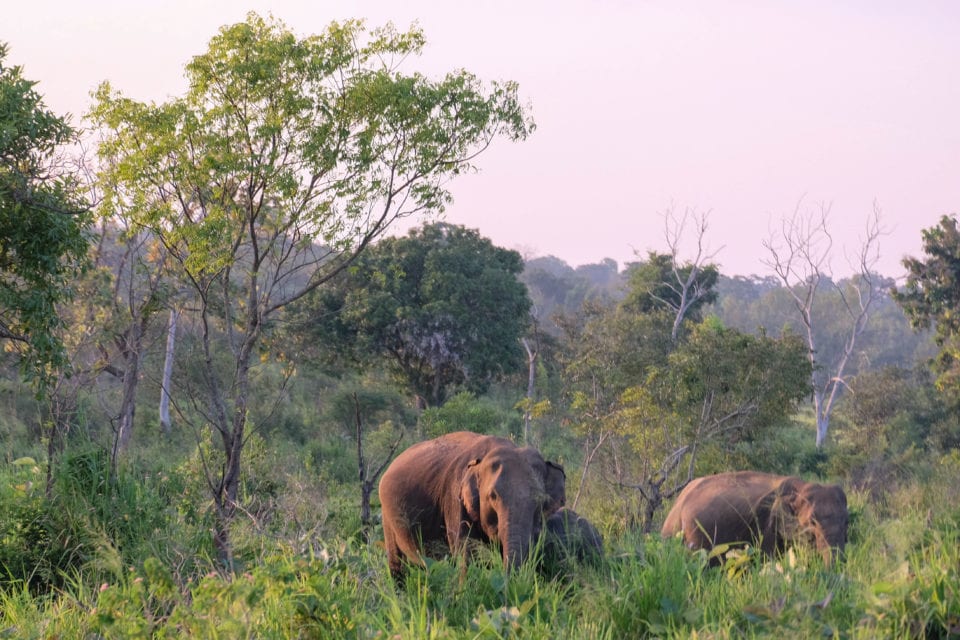
Horton Plains National Park
One of the best places to visit in Sri Lanka, Horton Plains National Park is an absolutely delightful place and should definitely be on your Sri Lankan itinerary. One of the coldest and windiest attractions in Sri Lanka, this UNESCO World Heritage Site consists of marshy lands, grasslands, Montane evergreen forests, etc. which gives it a unique feel. In this national park, you have a 10-km circular hike which takes you to some of the most amazing viewpoints and also offers you sightings of a few animals like Otter, Wild Boar, Barking deer, endemic Bear money, etc. on the way.
Apart from the beautiful views and the diverse flora and fauna, you also have some great views to interest you here. There are three major stops in this national park: World’s End, Little World’s End, and the Baker’s Fall. If you start the hike from the right path then you would encounter the Baker’s Fall first, then the World’s End and finally the Little World’s End. However, if you take the left path, then the order of viewpoints is reversed. The hike is mostly easy and can be completed in just 4-5 hours, but the misty weather can often hide the views.
One of the major attractions in this national park is the World’s End, located at an altitude of 2140 m, which is a long cliff with a 900m fall. From here, you can see the entire valley along with the small villages and towns which are settled here. It is an exciting feeling to stand at this point and see the drop as there are no railings to keep you protected so, it is advisable to be careful when standing near the edge.
Travel Tip: Arrive early in the morning, around 8 a.m., to enjoy a clear view from the World’s End viewpoint.
Horton Plains National Park written by Rachita Saxena of Nomllers Instagram @meanderandwander
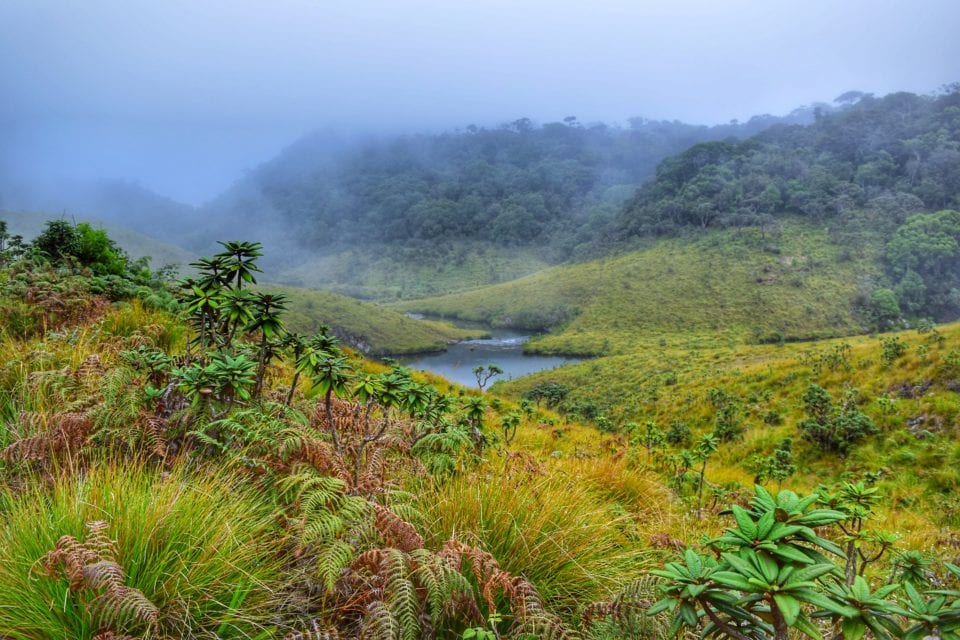
Udawalawe National Park
If you love wildlife, and especially elephants, you absolutely must visit Udawalawe National Park while you’re in Sri Lanka. Udawalawe National Park is one of the best places in South-east Asia to see elephants in the wild.
The park is 200 kilometers south-east of Colombo, and it is easily accessible by private driver or by bus if you are on a tight budget. Only 4WD safari cars are allowed to enter the park, so once you arrive in Udawalawe, you will need to organize your safari. You can either do that at the park’s entrance or directly at your hotel.
The best time to visit the park is at sunrise or at sunset when the animals are more active and when they congregate around the watering holes. Be sure to stay at least overnight near the park.
Of course, the elephants are what everyone visiting the park wants to see, but you’ll also see lots of birdlife, water buffalos, crocodiles, and deer. If you are really lucky, you might even spot an elusive leopard. When we were there, we saw so many elephants and some were only a few months old. We watched them bathe, play with each other, forage for food and throw dirt over themselves to keep cool. Observing them in their natural environment was the highlight of our trip to Sri Lanka.
Tips for Travelers: Hire a private driver to take you around Sri Lanka. They are very cheap in Sri Lanka, and it gives you the flexibility to visit only to the places you are interested in. Most hotels will provide driver accommodation for a very low cost. For us, it worked out cheaper than taking an organized tour. We really loved this option.
Udawalawe National Park written by Cindy Collins of Free Two Roam Facebook @freetworoam

Lunugamvehera National Park
Most people visiting Sri Lanka add Yala to their list of must-visit places. This makes total sense, since Yala is definitely one of the best national parks in the country, and there are great chances to see leopards – but the flip side of this is that Yala gets incredibly crowded, and visitors end up feeling as if they were in a zoo. On top of that, many tourists are unaware that Yala is actually closed in September and October each year. A great alternative to Yala National Park is Lunugamvehera, also known as ‘Yala Block 5’ because of its vicinity to the more famous national park.
Chances of seeing leopards at Lunugamvehera are not as good as in Yala, which probably explains why this park is only visited by a handful of people. However, there are great chances to see many other species like elephants, spotted deer, wild pigs, water buffaloes, and peacocks. Lunugamvehera is also a great birdwatching location since the national park was actually established to protect bird species gathering around the Lunugamvehera reservoir. During our visit, we got to see a variety of birds, including bright green bee-eaters and sapphire-coloured kingfishers.
All in all, we loved our visit to Lunugamvehera national park, especially because we only see five other jeeps during our visit, and we were always kept at a distance from animals, to prevent causing distress. You may not see as many animals as in Yala, but you can rest assured your interaction won’t be harmful to wildlife.
Sri Lanka Travel Tip: Make sure you have a long lens on your camera for wildlife photography.
Lunugamvehera National Park written by Margherita Ragg of The Crowded Planet Instagram @the_crowded_planet
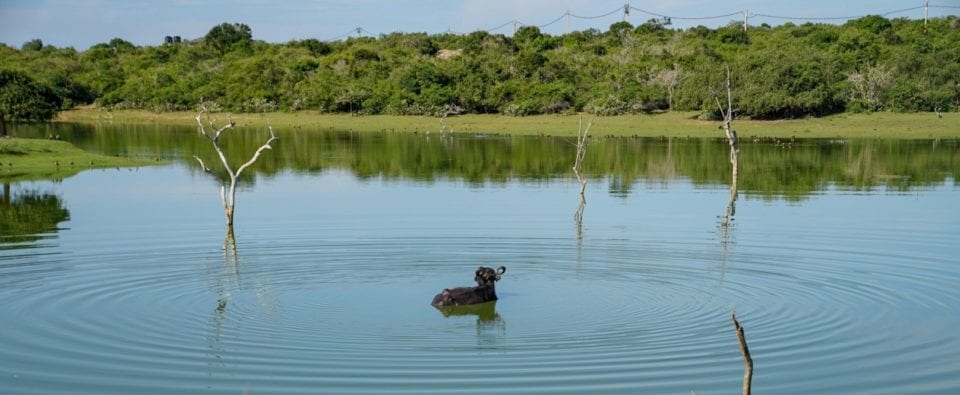
Yala National Park
Yala National Park is a ‘can’t-miss’ destination in Sri Lanka for numerous reasons. Firstly it is one of the few places that you might get to see the elusive Leopard in the wild. What could be more amazing than that! Secondly is all the other animals you can see from elephants (in an elephant friendly way, they are wild here), monkeys, birds, and maybe even a crocodile! The landscape of the park itself is also gorgeous and well worth the trip to see.
You can book your safari well in advance or the day before in a nearby town, depending on how well planned you want your trip to be. All the safari’s start in the early morning when animals are most active, and you have the option to do a full or half day. I highly suggest only to do the half day as you have to wake up early and likely will feel pretty beat from the bumpy roads and the morning is when you will see the best animals anyway. Your half day trip will come with breakfast at the beach where sometimes if you are very lucky you will see elephants. What breakfast contains will vary depending on your tour operator, some can be a simple spread of fruit and others more elaborate (directly related to the cost of the safari you picked!).
Yala National Park written by Candiss Koenitzer of Lost Not Found Instagram @Lost Not Found

Parting Thoughts on Visiting Sri Lanka
Sri Lanka is a land of ancient traditions and natural beauty, where cool mountain streams flow into the warm Indian ocean. It’s a land of change and preservation where your ethical tourism choices and dollars can really make a difference. Most of all, whether you’re adventuring on the southern tip or exploring the Northern Provenience, it’s an experience you’ll remember for a lifetime. We hope you have enjoyed this guide and that it has inspired to visit this beautiful country. We’d also like to thank all of our contributors and hope that you will check out their sites if you like their work. Sri Lanka is calling. Will you answer?
Like it? Pin it for later on Pinterest!


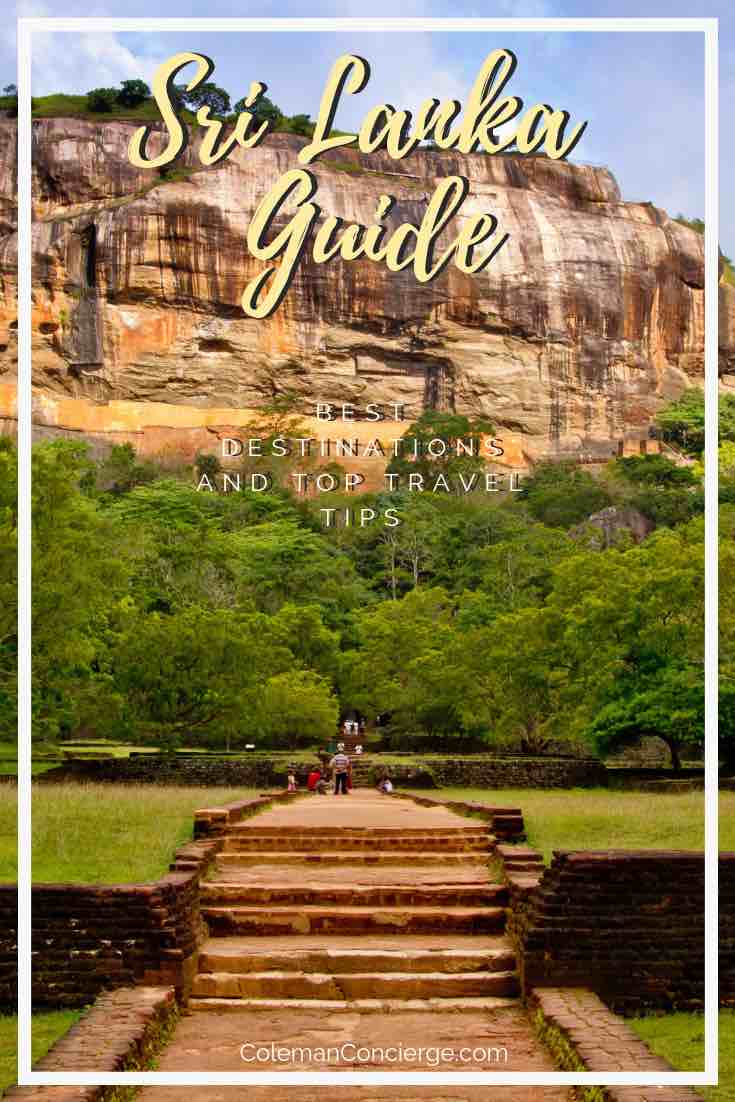
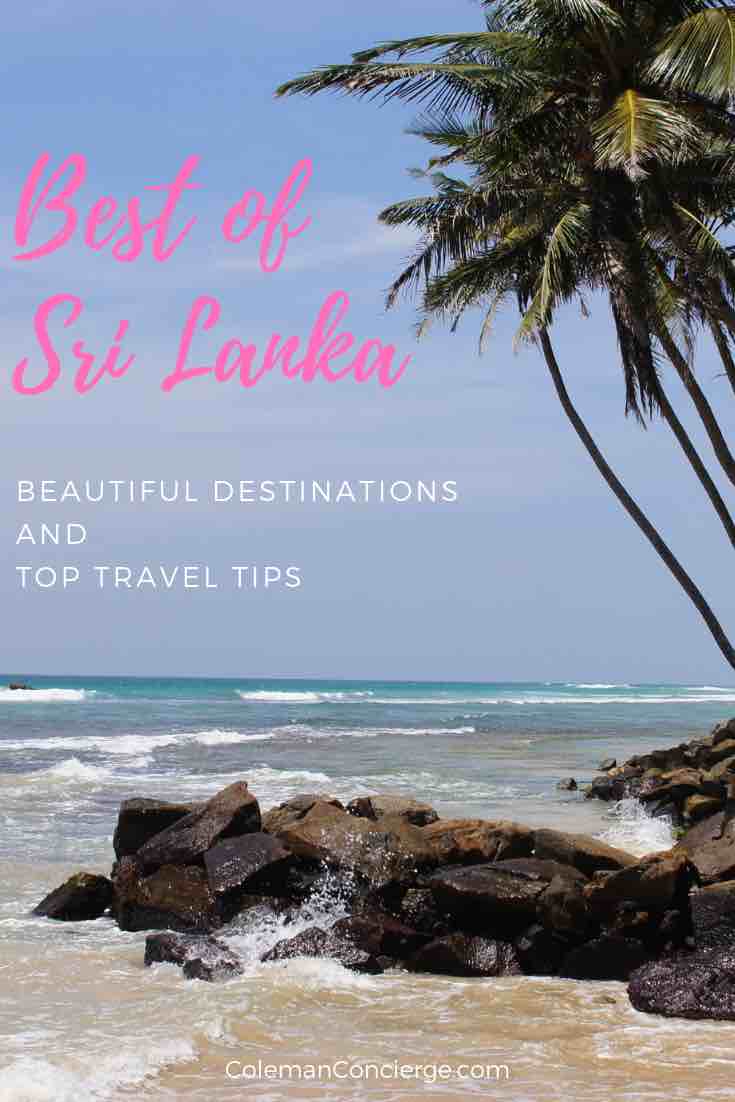
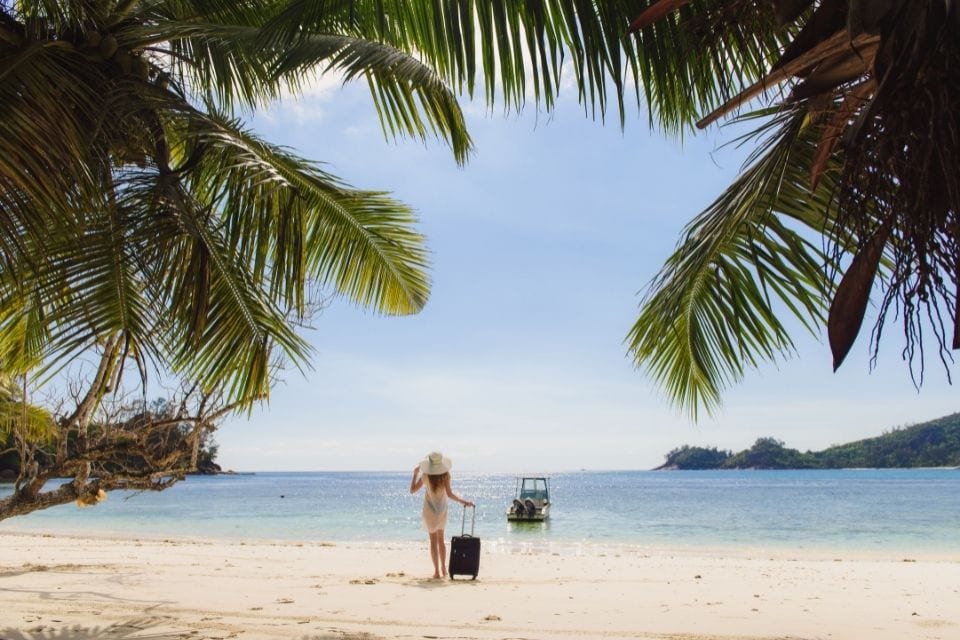
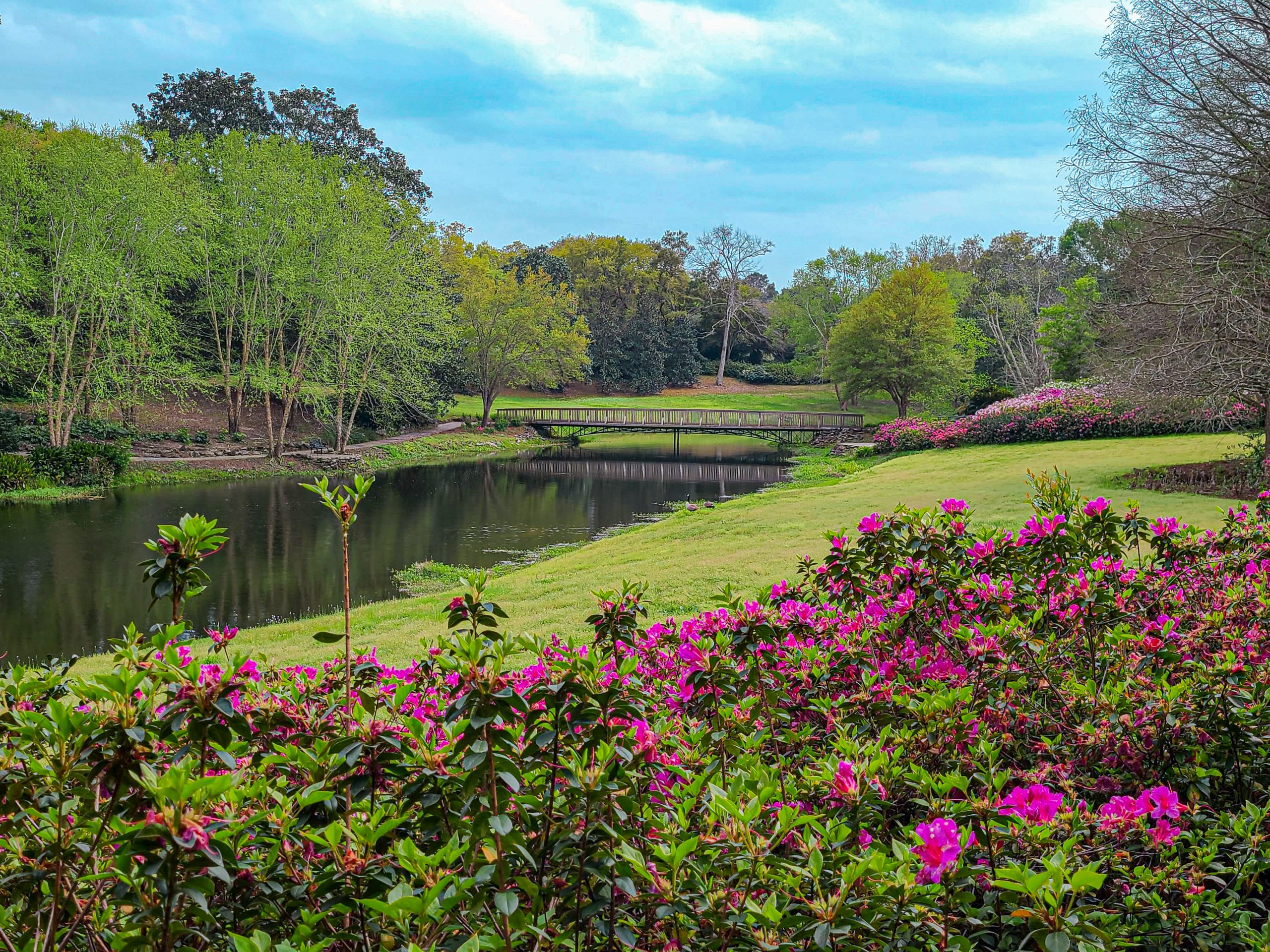
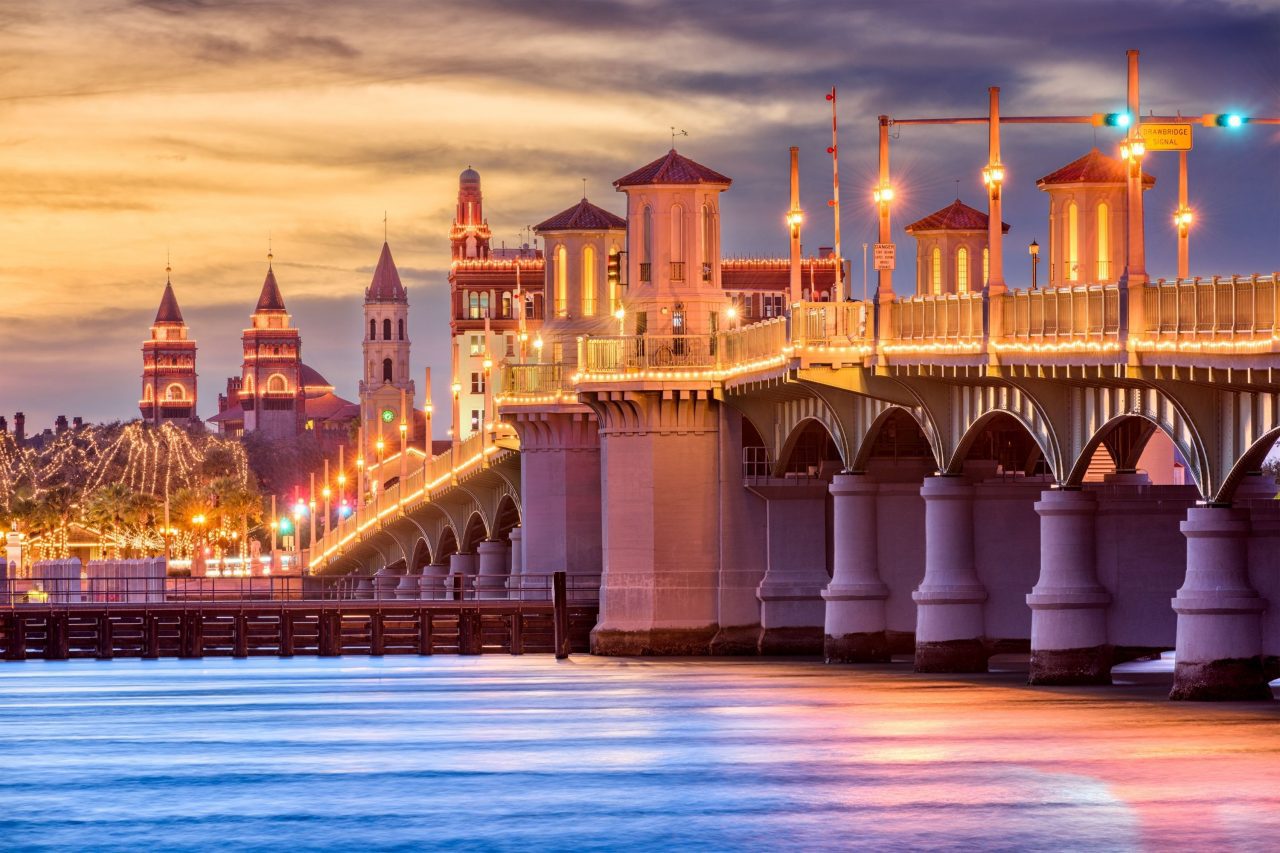
 Hi! We are Jenn and Ed Coleman, and together we are Coleman Concierge. It is our goal to inspire you to get out, expand your world, and to seek adventure, even in your own backyard.
Hi! We are Jenn and Ed Coleman, and together we are Coleman Concierge. It is our goal to inspire you to get out, expand your world, and to seek adventure, even in your own backyard.













One Response
very perfect article thanks for sharing it with us.